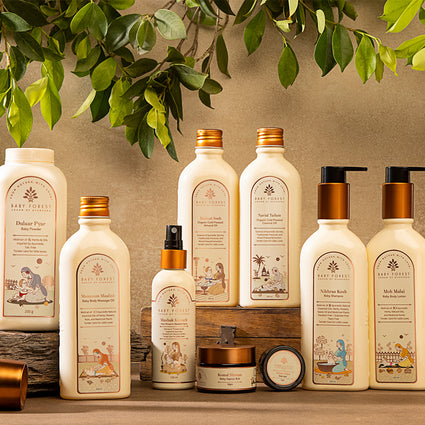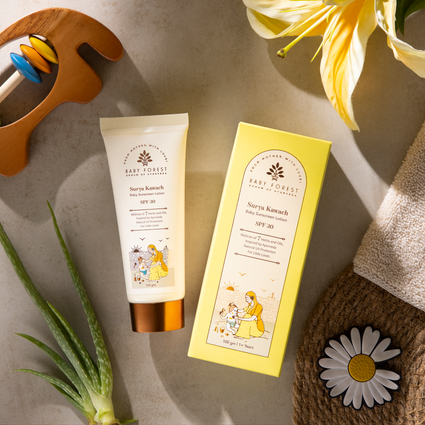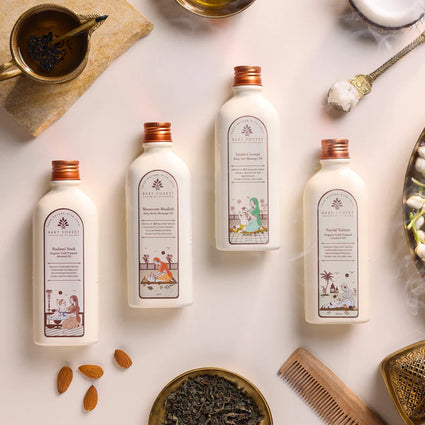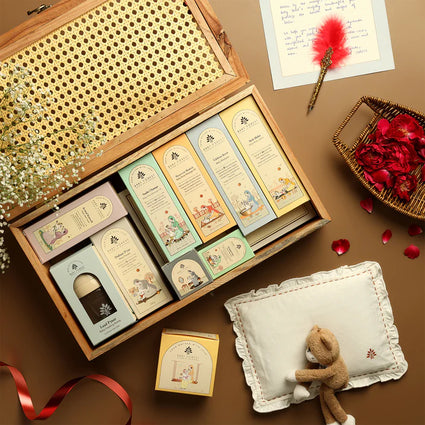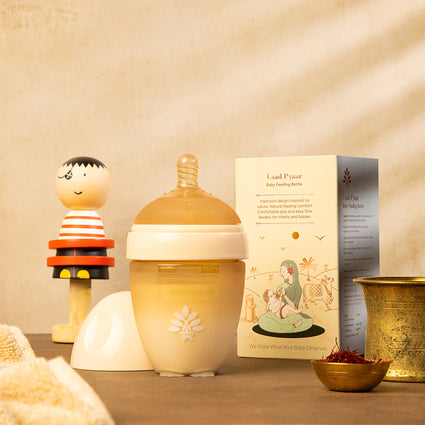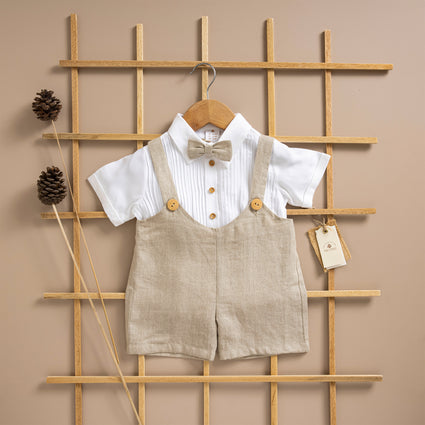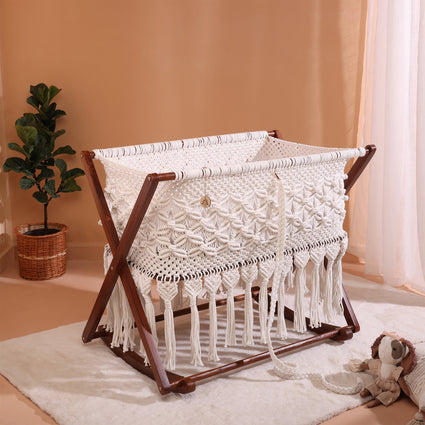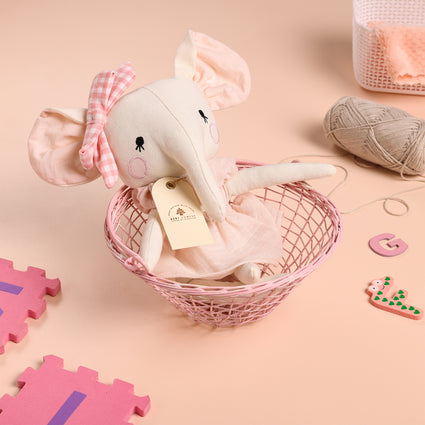Baby Care & Parenting Blogs

Mustard Seeds Pillow Benefits: Ideal for Your Newborn's C...
We all know how serene and adorable it is to see a baby sleeping so soundly. In the initial months, the baby needs crucial care for everything. It takes a while for them to handle the weight on their neck. And secondly, they sleep a lot! These concerns can collide with the baby's head and neck posture while sleeping. A mustard pillow has lived from generation to generation to better shape a baby's head. Here are some of the benefits of using a mustard pillow for your baby:
Understanding Mustard Seed Pillows
Mustard seed pillows, also known as rai pillows, are specially designed for newborns to provide optimal head support and comfort. These baby pillows are filled with mustard seeds, which allow them to conform to the shape of a baby's head, reducing the risk of developing a flat head. The use of a mustard pillow for newborns is an age-old practice rooted in traditional wisdom, and it continues to be favored by many parents today for its natural and gentle support.
Benefits of Using a Mustard Pillow for Newborns:
Ensuring a Round and Well-Shaped Head:
While in the womb, the baby's head might be a little conic or unevenly molded. Once they have entered the world, they need some assistance to gain the round shape of the head. The roundness comes with the proper headrest! Mustard Pillow provides precisely what is required most naturally. It wraps the baby's head with its softness and supports it comfortably while they are asleep.
Prevents Extra Pressure:
A baby's skull is very delicate, with bones that are not yet fused and soft spots on the head called fontanels that require the utmost care. The seeds in a mustard pillow are unfixed, allowing them to move according to the baby's head shape. This provides transferable structural support and prevents excessive pressure from being exerted on the baby's head and neck.
Keeps Them Warm
Mustard is a natural heater. It consists of good vitamins like Vitamin C, K, and thiamin and compounds of antioxidants like carotenoids and kaempferol. It relieves the baby from every day but fearful situations like the common cold and cough. The warm properties are the natural cure wrapped up in the comfort of a pillow. It protects the baby from ear infections, promotes blood circulation, and even helps with any strain collected by the head.
The Science Behind Mustard Seed Pillows
The science behind mustard seed pillows lies in their unique ability to distribute pressure evenly across a newborn's head, thereby preventing flat head syndrome, also known as positional plagiocephaly. The small, round seeds create a malleable surface that adapts to the infant's head shape, promoting even growth and development. Moreover, the mustard seeds provide natural warmth, which can have a soothing effect on babies, helping them sleep more soundly. Using an infant pillow for flat head concerns, like a mustard seed pillow, combines both traditional practices and a modern understanding of infant care.
Why Choose the Soumya Aakaar Head Shaping Pillow?
The Baby Forest Soumya Aakaar pillow is crafted from the purest organic cotton, the finest mustard seeds, and the soothing benefits of supreme lavender herb. The organic cotton provides gentle care for the delicate head, while the mustard seeds offer essential support and shaping. Additionally, lavender naturally soothes the baby, promotes comfortable sleep, and keeps bugs away naturally.
Related Read: A Guide to Creating the Perfect Sleep Space for Your Baby
As parents, we all know how important a pillow is for babies; it is not only about sleep but also plays an essential role in their early development. Our traditions never fail to have the best of nature for the best upbringing, and we try to make it accessible to all.
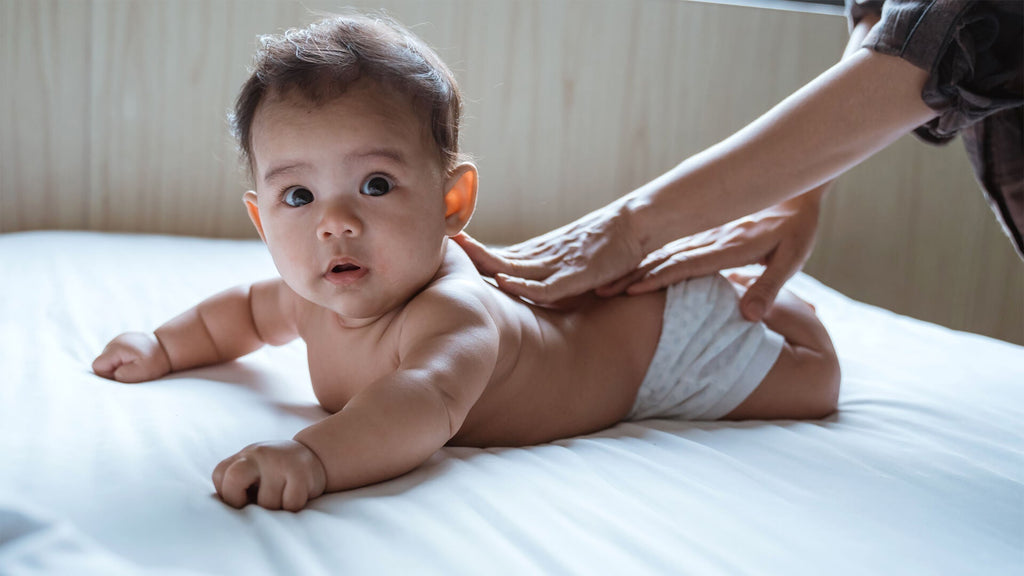
Shishu Abhyanga (Baby Oil Massage): The Ancient Ayurvedic...
Shishu Abhyanga or Baby Oil Massage, is an ancient Ayurvedic tradition widely practiced in India among new parents. It is well-known that regular oil massage has many benefits for a baby. Infant’s skin is delicate and sensitive; therefore, daily oil massage can promote healthy skin, provide relief from dryness, and hydrate skin to keep your baby protected. In addition to this, your baby will have increased blood circulation, strengthening the immune system and enhancing physical development. Hence, baby massage is a ritual that promotes physical, mental, and emotional well-being and can be performed daily to promote strong bonding between mother and child.
We’ve put together a baby massage guide featuring simple step-by-step instructions so that anyone can easily practice this ancient Ayurvedic tradition at home. Before starting a massage, you must take some precautions as described below:
Precautions:
- Abhyanga should be done preferably in the morning.
- Use a clean sheet while giving a massage.
- Use a slightly warm oil for giving a baby massage. Take a few drops on your palm before applying to your baby’s skin to avoid skin burn.
- Do not give a massage on a full stomach as sudden aspiration can occur. If the baby has been fed, it is best to wait for an hour before the massage.
- The pressure should be gentle to moderate.
- Massage must be done with clean hands and nails. You must trim the nails to avoid causing any harm to the baby’s skin.
- Make sure oil is not in contact with the baby’s eyes.
- Use caution when holding and massaging the baby to avoid falls and injuries.
- Babies should always be kept warm & well covered after Abhyanga.
Step By Step Process to Give Shishu Abhyanga:
Baby oil massage can be one of the best ways to bond with your baby. Not only does it help you to connect with your baby, but it also helps to relax them, making it easier for both of you to fall asleep at night. However, performing a massage can be difficult when you have never done one before. Here is a step-by-step process to give your baby a massage using baby oil in simple steps:
Step 1: Get Your Baby Ready
The first thing you must do is get your baby ready for their massage. You should make them feel comfortable and relaxed, so make sure that they are wearing something soft and comfortable, such as a t-shirt or onesie. It is also important that the room is warm enough, so check the room temperature on your thermostat to ensure that it is comfortably warm for your baby.
Step 2: Prepare the Area
You will need ample area to give Shishu Abhyanga. The bed, floor, or changing table are good options. Then place a towel on the surface and lay your baby down. The towel will prevent you from getting baby oil on the beg or table, and it will also provide a comfortable, soft surface for your little one.
Step 3: Select Oil
Always select an unscented oil that’s safe for babies, such as mineral oil, coconut oil, or olive oil. You can give a massage with Baby Forest Maasoom Maalish baby body massage oil. This oil is a mishran of 10 Ayurvedic natural essential oils of herbs, flowers, nut oils, and medicinal plants that are good for baby skin.
Pour some onto your hands and rub them together to warm it up before you start massaging your baby’s body.
Step 4: Lower Body Massage
Slowly massage heels and toes with firm, gentle strokes. Hold baby by one hand at all times. Then massage the leg from ankle to thigh and from hip to hip. Smoothly massage the leg for several minutes. It is recommended to do this on both legs simultaneously. Do not rub the genital area.
Step 5: Upper Body Area
Massage the upper back by placing both hands in the downward direction from shoulders to waist. After that, massage each arm separately. Start from the wrist up to the shoulder by making circular motions with the fingers and palms of hands. Repeat this process for another arm also.
Step 6: Back Massage
After massaging the front of your baby’s body, turn them onto their tummy and massage them from head to toe. Make sure your touch is soothing. Take a pause if you feel your baby is uncomfortable.
Step 7: Face Massage
Massage the baby’s face with your finger pads. You should begin at the middle of the forehead, down the outer side of the baby’s face, and then in toward the cheeks. Gently massage the scalp in small circular motions.
When to Perform Abhyanga Properly
Abhyanga, or Ayurvedic oil massage, can be introduced to newborns after their umbilical cord stump has healed, typically around 10-14 days old. The best time to perform Abhyanga is before a bath, ideally in the morning or early evening when the baby is calm and alert. Ensure the room is warm and draft-free to keep the baby comfortable. Abhyanga can be done daily or several times a week, depending on the baby's skin type and routine. It is essential to observe the baby's response to the massage and adjust the frequency and duration accordingly to ensure a positive and soothing experience.
Benefits of Shishu Abhyanga
Shishu Abhyanga, or infant massage, offers numerous benefits for both the baby and the caregiver. It promotes better sleep patterns and helps in the development of the baby's nervous and immune systems. Regular massage can improve blood circulation, support healthy skin, aid in digestion, and reduce colic and gas. Additionally, Shishu Abhyanga strengthens the bond between the baby and the caregiver, providing a sense of security and comfort through physical touch. The gentle massage also helps in the overall growth and development of the baby, contributing to a calm and happy demeanor.
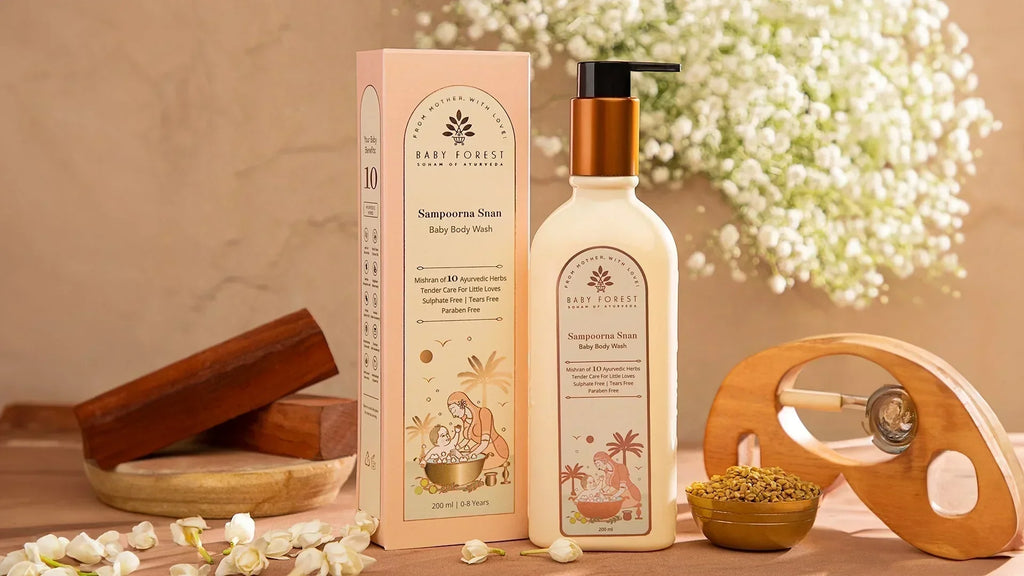
Which Baby Body Wash Is Right for Your Little One?
Body washes are a convenient and soothing way to cleanse your baby's delicate skin. Unlike traditional soaps, which can be drying, and harsh, organic body washes are formulated to be mild and moisturizing, making them a great choice for daily use. Choosing the right baby body wash is crucial because their skin is much more sensitive than adult skin. With countless options available, it can be overwhelming for new parents to find one that is safe, gentle, and nourishing. To simplify your decision, let's delve into the benefits of various natural ingredients found in baby body washes that are effective and gentle. Additional Tips for Bathing Your Baby e on your little one's tender skin.
Understanding Baby Skin
Baby skin is thinner and more susceptible to dryness and irritation compared to adult skin. This is why it's important to choose products specifically designed for babies — products that moisturize and protect without using harsh chemicals. A baby body wash with natural, soothing ingredients can help maintain the natural softness and health of your baby's skin.
Key Natural Ingredients to Look for in Baby Body Washes
When selecting a baby body wash, look for these natural ingredients known for their skin-friendly properties:
-
Jaee Giri (Oat Kernel)
Known for its soothing properties, oat kernel is excellent for baby's sensitive skin. It helps to calm irritation and is incredibly moisturizing, making it perfect for keeping your baby's skin soft and well-hydrated. -
Narial Tailam (Coconut Oil)
Coconut oil is a wonderful moisturizer and is known for its antibacterial and antifungal properties. It's gentle enough for daily use on baby's skin and helps in treating and preventing diaper rash. -
Methika (Fenugreek Leaf)
Fenugreek has natural anti-inflammatory properties that can soothe a baby's skin. It is beneficial for combating cradle cap and eczema. -
Watermelon
Rich in vitamins and water content, watermelon is a hydrating ingredient that keeps the baby's skin fresh and radiant. -
Parijata (Jasmine Oil)
Known for its calming and soothing effects, jasmine oil can help in relaxing your baby, making bath time a more pleasant experience. -
Amalaka (Indian Gooseberry)
A powerhouse of antioxidants, Indian gooseberry helps protect the skin from environmental damage and promotes healthier skin. -
Karpurapuspa (Chamomile)
Chamomile is another ingredient renowned for its soothing properties. It's especially good for babies with irritated or inflamed skin due to its anti-inflammatory benefits. -
Chandana (Red Sandalwood)
Often used in Ayurveda, red sandalwood can help cool and soothe the skin, making it ideal for use in baby body washes. -
Ghrit Kumari (Aloe Vera)
Aloe vera is hydrating and soothing and works well to treat and prevent dry skin patches and diaper rashes. -
Madhukarkati (Grapefruit)
Known for its refreshing scent and cleansing properties, grapefruit is a natural astringent which helps keep your baby's skin clean and refreshed.
Buying the Right Baby Body Wash
When choosing a baby body wash, always opt for products free from parabens, sulfates, and artificial fragrances, which can irritate delicate skin. Look for tear-free products that are derma-safe. Reading product labels and choosing washes that list natural ingredients can help ensure that the product is gentle and safe for your baby.
Additional Tips for Bathing Your Baby
- Before bathing your baby, always remember to test the water temperature.
- Use a soft washcloth to gently apply the body wash.
- Keep bath time short, especially if your baby has very dry or sensitive skin, to avoid further drying out the skin.
- After bathing, gently pat your baby's skin dry with a soft towel and apply a mild moisturizer to retain moisture.
Choosing the right body wash for your baby is about finding a balance between gentle, effective cleansing and skin nourishment. With the right natural ingredients, you can ensure that your baby's skin remains healthy, hydrated, and happy. Remember, every baby is different, so what works for one may not work for another. Don't hesitate to consult with a pediatrician if you have concerns about choosing skincare products for your baby.
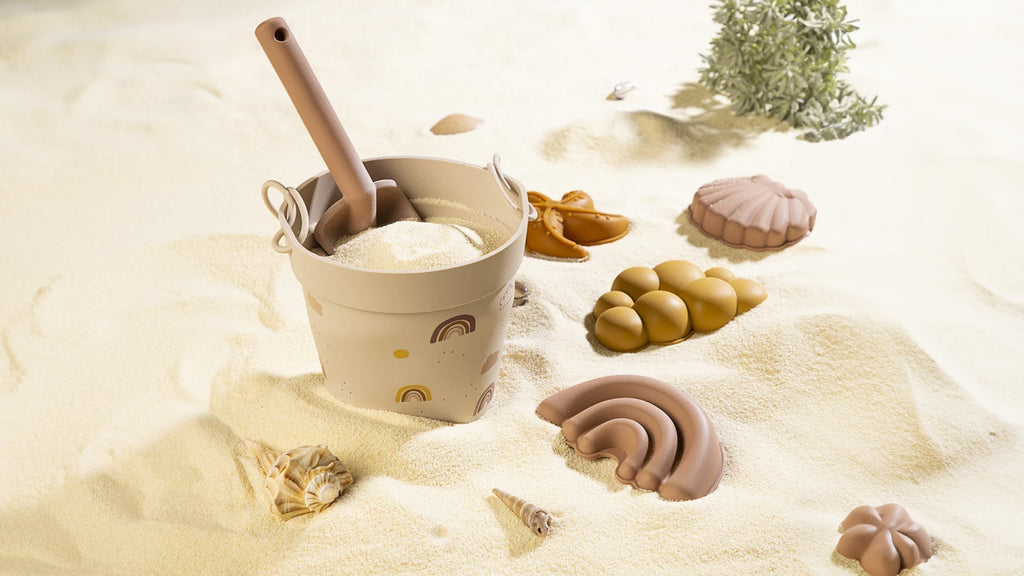
Essential Tips for a Perfect Beach Day with Kids this Summer
A beach day with kids can be a great way to spend the summer, but it takes careful planning to ensure everything runs properly. There are various factors to consider, like carrying the appropriate gear and keeping your children safe and entertained. This blog contains a few tips to help you have a fantastic beach day with your children.
Preparation is Key
Before you head to the beach, make a checklist of all the items you need to bring. Preparation ensures that you have everything necessary to keep your children comfortable, safe, and entertained. This includes beach toys, sun protection items, food, and drinks. It's always better to be over-prepared than to realize you've forgotten something crucial once you're already at the beach.
Sun Protection
One of the most important aspects of a beach day is protecting your kids from the sun. Young children have sensitive skin that is more prone to sunburn. Apply a broad-spectrum SPF30 baby sunscreen lotion to your child's skin about 30 minutes before sun exposure. Reapply every two hours or after swimming. Choose a sunscreen made exclusively for babies, ensuring that it is mild on their sensitive skin. Make sure your children are wearing wide-brimmed hats to shield their faces and necks from the sun. Setting up a beach umbrella or tent provides a shaded area where your kids can take a break from the sun. This is especially crucial during peak sunlight hours, which normally occur between 10 a.m. and 4 p.m.
Beach Toys and Entertainment
Keeping your kids entertained at the beach is crucial for a fun day. Bringing along the right beach toys can make a significant difference. The beach munchkin bucket is a versatile toy that can provide hours of entertainment. Your kids can use it to build sandcastles, collect seashells, or even catch small sea creatures. It's lightweight, portable, and ideal for beach trips. If your children enjoy swimming, inflatable toys and floaties are great additions. They can float on the water safely and have fun splashing around.
Baby Care Essentials
When spending a day at the beach with a baby, having the right baby care essentials is critical. Baby wipes are indispensable for cleaning up messes, wiping sandy hands, and even cooling down your baby's skin. Choose wipes that are gentle and free of artificial fragrance to avoid irritation. Talc-free baby powder is perfect for removing sand from your baby's skin. Sprinkle some powder on their skin and brush off the sand effortlessly. This simple trick can keep your baby comfortable and free from irritation. Keep your kids hydrated by offering water frequently. Pack healthy snacks like fruits, crackers, and sandwiches to keep their energy levels up throughout the day.
Appropriate Beachwear for Babies
Choosing the right beachwear for your baby is essential for their comfort and protection. A Hand Embroidered Gather Top with Underpants is a cute and stylish outfit that is perfect for a beach day. The lightweight fabric keeps your baby cool, while the hand embroidery gives a touch of elegance. The underpants provide coverage and keep the sand out. A full-sleeved baby bodysuit set offers excellent sun protection for your baby's delicate skin. Look for ones made from breathable materials that dry quickly. This outfit is perfect for cooler beach days or when you need extra sun protection. An overlapping baby bodysuit is simple to put on and remove, making diaper changes a quick game. The design ensures that your baby stays comfortable, and the soft fabric is gentle on their skin.
Safety Tips
Always keep a close eye on your kids, especially when they are near the water. Designate a responsible adult to supervise at all times. Teach your children basic water safety rules, such as not swimming alone and understanding the dangers of strong currents. Pack a simple first aid kit that includes bandages, antiseptic wipes, and other items you'll need to heal small wounds. Dehydration can occur quickly under the sun. Ensure your kids drink plenty of water and take breaks in the shade to cool down.
After the Beach
After a fun-filled day at the beach, there are a few things to keep in mind. Rinse off the sand and saltwater from your kids' skin and hair. Check your child's skin for any signs of sunburn. If you notice redness or irritation, apply aloe vera gel or a soothing lotion to ease the discomfort.
A beach day with kids can be a delightful and memorable experience with the right preparation and care. By ensuring proper sun protection, bringing the right toys, packing essential baby care items, and choosing appropriate beachwear, you can create a perfect beach day for your family. Remember to prioritize safety, stay hydrated, and engage your kids in fun activities. With these tips, you are well-equipped to enjoy a wonderful day at the beach with your little ones this summer.
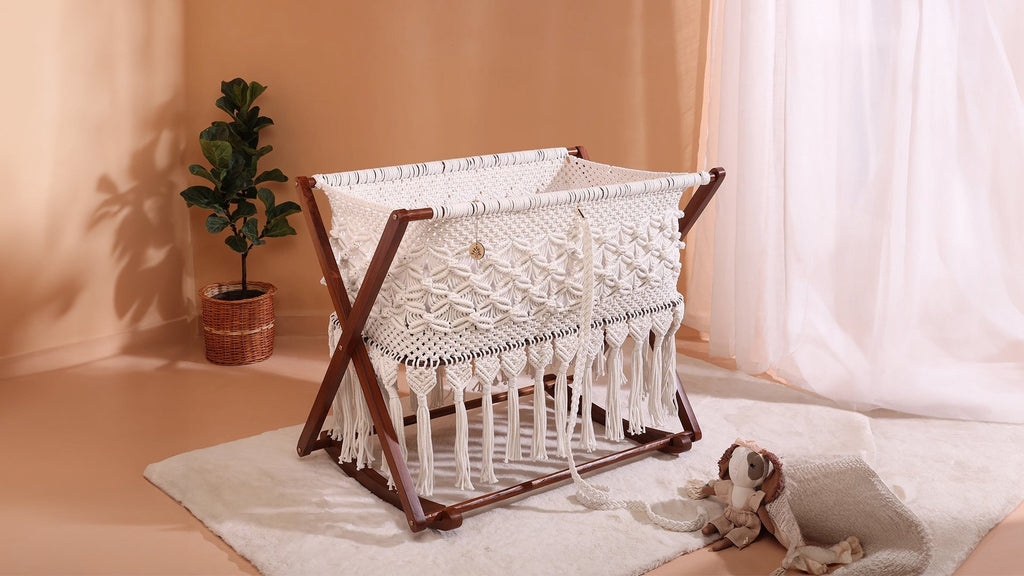
07 Things to Know Before You Buy a Baby Cradle in India
Buying a baby cradle is one of the most significant decisions for new parents, as it provides a safe and comfortable space for your little one to sleep. With various options available in the market, choosing the right cradle can be overwhelming. This guide will help you understand the essential aspects to consider before purchasing a baby cradle in India, ensuring you make an informed and thoughtful choice.
Importance of a Handmade Cradle
Handmade cradles are crafted with care and precision, often featuring unique designs and superior quality. Usually, these cradles are crafted by expert artisans who take great care to ensure both longevity and safety. A handmade baby cradle not only adds an aesthetic appeal to your baby's nursery but also provides a personal touch that mass-produced cradles lack. In India, handmade cradles are often made from natural materials like wood, which are safe and non-toxic for your baby.
Benefits of a Detachable Rocker
A detachable rocker is a valuable feature to look for in a baby cradle. The gentle rocking motion mimics the movements of a mother's arms, providing a sense of security and relaxation for your baby. This can be particularly soothing during nap times or when your baby is fussy. The ability to detach the rocker allows for versatility, as you can use the cradle as a stationary bed when needed. This feature ensures that the cradle can adapt to different situations and needs, making it a practical choice for parents.
Durability is Key
When buying a baby cradle, durability is a crucial factor to consider. You want a cradle that will last through your baby's early years and potentially be used for future siblings. Look for cradles made from sturdy materials like natural wood, which is known for its strength and longevity. A well-made cradle will endure normal wear and tear and give your child a secure place to sleep. Check for features like strong joints, smooth finishes, and stable bases to ensure the cradle's durability.
The Charm of Natural Wood
Natural wood cradles are a popular choice among parents due to their aesthetic appeal and safety. Wood is a durable and sturdy material that provides a stable sleeping environment for your baby. In addition, natural wood is suitable for young children because it doesn't contain any poisons or dangerous compounds. Wooden cradles also tend to have a timeless look, fitting seamlessly into various nursery themes and styles. Wood is also simple to keep and clean, so your baby's sleeping space will always be safe and hygienic.
Ease of Assembly
As a new parent, you'll appreciate a cradle that is easy to assemble. Look for cradles that come with clear instructions and all the necessary hardware. Choosing an easy-to-assemble cradle saves time and allows you to prioritize other duties. Additionally, an easy-to-assemble cradle can be conveniently moved and reassembled in different rooms as needed. This flexibility is especially beneficial in the early months, when you may want to keep your infant close at all times.
Value for Money
When investing in a baby cradle, it's important to consider the value of money. While it might be tempting to opt for the cheapest option, remember that a high-quality cradle will provide better safety, comfort, and durability. Consider the features, materials, and craftsmanship of the cradle to ensure you're getting the best value for your investment. A durable cradle can be used for several children and passed down to future generations, making it a good investment.
Baby Forest's macrame wooden baby cradle combines the beauty of handmade craftsmanship with the durability of natural wood. These cradles frequently contain complex macrame designs, which offer a sense of elegance to the nursery. The gentle, detachable rocking motion of a macrame wooden cradle mimics the soothing movements of a mother's arms, helping your baby feel secure and relaxed. Measuring approximately 36x36x20 inches, these cradles are ideal for babies up to 3 years of age, providing a comfortable and spacious sleeping area.
Related Read - A Guide to Creating the Perfect Sleep Space for Your Baby

Here’s everything you need to know about Sun Protection F...
Babies are the happiness factor in a family when it comes to the family HQ (Family Happiness Quotient). With Summer at its peak, all parents must make sure that their baby must be sun protective at all times of the day. With so many options of sunscreens available in the market these days, it becomes a task to choose the best one for your little one. In this article, we get straight to the point and provide you with a well-elaborated overview of sunscreen usage for babies and all-around advantages for one’s health.
"Better a sun-kissed than sunburned!" This proverb has more relevance to baby skincare than anything else. Choosing the right baby sunscreen or sunblock, among other things, is an important step in the direction of security concerning the scorching summer heat & UV rays. Parents should look for more natural ingredients than chemicals when it comes to choosing the right sunscreen for their little ones.
Reading labels & making informed choices should be the goal of every parent before applying anything to their baby’s skin. The key requirement is a thorough understanding of the ingredients in the sunscreen and how they are aligned with the specifications for your baby’s skin. Alongside applying sunscreen, one must also ensure the baby is protected with a physical layer of clothing.
There is a very fine line between protecting the skin and protecting the skin with comfort. Organic cotton clothing ensures that the skin area is aerated to avoid overheating. Studies suggest that when using Sunscreen, one must dress the little ones in breathable clothing.
Understanding the concept of UV rays
The UV rays on earth are majorly of two types UVA & UVB rays. While UVA reaches the earth at about 95%, UVB reaches the rest at 5%. As mentioned, Sunlight is good for the baby, one must make sure that the baby is exposed to the morning sunlight only for a reason (The morning UV rays are UVB(generally good for the skin). UVB rays delay tanning & don’t age skin cells. When it comes to the Sun Protection for babies, there is science involved. At birth, the babies are born with a lesser amount of Melanin in their skin, with development in the next 6 months.
SPF (Sun Protection Factor) ranked on the seal is also a vital element to bear in mind. Babies & kids need SPFs of 15 to 30. Therefore, doctors and dermatologists commonly recommend it. A mild range could have provided ample protection without being too harsh on the baby's skin. Parents need to understand that, SPF is not a factor in being protective from sun rays, rather SPF rating denotes protection from UVB rays. Higher SPF doesn’t mean better protection, rather, is directly proportional to the duration of sun protection. Applying and reapplying sunscreen isn't enough, even SPF can only show its real effectiveness in sun exposure combined with other factors.
Specialists believe that having sunscreen should take at least 15 to 30 minutes before one dives into the sun. This makes sure that the sunscreen is absorbed completely by the skin and that all its protective factors can be utilized completely. The most important thing is reapplication of SPF every 2 hours to stay above that optimal protection where the exposure time is extended by the sun.
But while we talk about the application of sunscreen, it is always recommended to do a patch test on your baby as recommended by the FDA, as their skin is delicate and sensitive & might get affected by any ingredient of the product. As mentioned, higher SPF doesn't necessarily mean better protection against the sun despite the myths around the number. SPF 15 blocks out about 93% of UVB radiation, while SPF 30 offers 97% protection. If you use an SPF rating of 50 and above there is not significant protection increase.
As per reports, it is always recommended to use natural ingredients like Sea Buckthorn, Cocoa Butter, & Daffodil that not only protect the baby’s skin but also hydrate & enrich their skin as well. These elements don't just make the products effective but also help to support the baby`s skin's overall health and well-being at the same time.
In conclusion, the need to apply sunscreen to babies should be stressed tremendously. Sunscreen offers much more than UV protection to the skin of a baby. It guards against sunburn and shields from long-term harm to the skin, making it mother's primary skincare partner. Sustaining the experts' recommendations and acknowledging the parents to be alert will ensure that the infants' delicate skin soaks in the sun's rays under the protective covering on the right note, by no means affecting the little one's skin health.
Related Read - The Importance of Sun Protection: Why Baby Sunscreen is a Must
Related Blog - Top Summer Baby Care Essentials for Your Little One
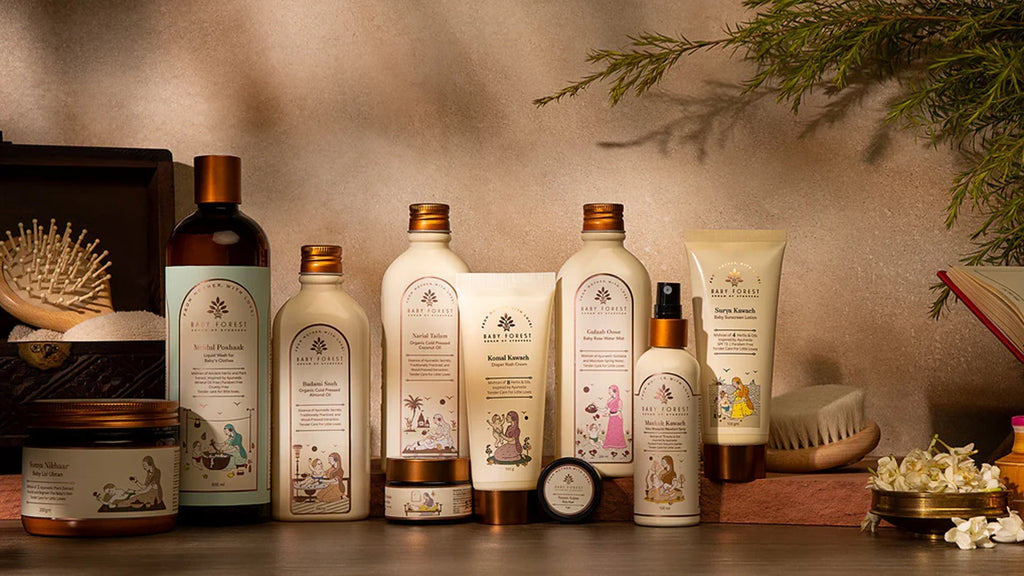
Top Summer Baby Care Essentials for Your Little One
With the changing weather and the temperatures rising, the days grow longer, so ensuring your little one remains comfortable and protected through the summer months becomes a priority. You must take care of your little one, especially during the hot summer days. In this blog, we have curated a list of essential summer baby products and tips to keep your baby happy and healthy during the warm season. From baby skincare to travel essentials, we have a detailed guide designed to cater to your baby's unique needs this summer.

Baby Skincare and Bathing
Summer calls for extra care and attention to skincare and bathing to prevent irritation and keep your baby's skin healthy. The two must-have products are:
Water Baby Wipes

These water wipes are ideal for sensitive skin. They are infused with purified water and free from harsh chemicals, ensuring a gentle cleanse every time.
Rash Healing Cream

With the heat leading to more frequent cases of diaper rash, a reliable cream is essential to soothe and protect your baby's delicate skin.
Baby Sunscreen Lotion

The delicate skin of babies is particularly vulnerable to the harmful rays of the sun. Choose a sunscreen specially formulated for babies, with a high SPF to provide effective protection against UVA and UVB rays. You should apply the baby sunscreen 30 minutes before going out, and reapply frequently to ensure your baby stays protected under the sun.
Keeping your baby cool and comfortable outside is crucial during the hot weather.
Summer Clothing

We opt for warm clothes for winter, and similarly, for summer, it is essential to look at lightweight and breathable fabrics. You can get a crochet baby girl dress or a knotted bodysuit that allows air circulation and keeps your baby cool and stylish.
Baby Rose Water Mist

A refreshing mist can soothe and cool your baby's skin throughout the day. It's perfect for a quick refresh, especially after playtime or when outdoors.
Talc-free Baby Powder

Applying talc-free baby powder after a bath or during diaper changes can help absorb extra moisture and prevent heat rash.
Ensuring your baby is well-hydrated and comfortable is easier with these gentle and effective products.
Baby Body Lotion

After a day out, moisturizing your baby's skin with a baby body lotion helps restore any moisture lost due to exposure to the elements and can help in calming any minor irritations. This routine can help protect your baby's skin from environmental stressors.
Here are some additional tips for summer care to ensure your baby's comfort and safety during the hotter months:
-
Choose the Right Time for Outdoor Activities
Plan outdoor activities during the cooler parts of the day, typically in the early morning or late afternoon. Avoiding the peak sun hours between 10 a.m. and 4 p.m. can help minimize sun exposure. -
Use a Lightweight Stroller with a Sunshade
When taking your baby out for a stroll, use a lightweight and breathable stroller, and make sure it has a sunshade to protect your baby from direct sunlight. -
Dress Weather Appropriate
Dress your baby in loose, lightweight, and light-coloured clothing that covers as much skin as possible. Fabrics like cotton help keeps the skin cool by allowing it to breathe. -
Maintain a Cool Indoor Environment
Use fans, air conditioners, or open windows to create a comfortable and relaxed indoor environment. Consider using a room thermometer to keep track of the temperature, ensuring it's not too hot or too humid. -
Frequent Baths or Cool Washes
Giving your baby a cool bath or gently wiping them down with a damp cloth or baby wipes can help reduce body temperature and soothe irritated skin. -
Monitor Fluid Intake
Ensure your baby is well-hydrated. If they are exclusively breastfed, they might need to nurse more often. If your baby is older and eat solids, offer small amounts of water throughout the day. -
Regularly Clean and Check Baby Gear
Clean all baby gear using a baby-friendly toy and surface cleaner. Including strollers, car seats, and play mats, as heat and humidity can cause bacteria and mold to grow faster than usual.
Summer brings a host of new adventures for you and your baby, but it also calls for a shift in the caregiving routine. You can ensure that your little one enjoys the season safely and comfortably by choosing the right products, such as lightweight cotton clothing, gentle skincare items, and proper sun protection. With this, you can enjoy the sunny days ahead with peace of mind, knowing you're fully equipped to handle the heat!
With these summer essentials, your baby will be well-prepared to face the warm months, and you can enjoy this vibrant season with less stress and more joy.

The Benefits of Regular Baby Massages - A Parent's Guide
As a parent, you're always looking for ways to give your baby the best start in life. One simple yet profound method to boost your baby's health and strengthen your bond is through regular baby massages. Baby massage is an age-old tradition with numerous benefits that can support your child's emotional and physical development. This guide will explore why incorporating massage into your daily routine can be a rewarding experience for both you and your baby.
Baby massage involves gently rubbing and kneading your baby's body with your hands. By using baby massage oils or moisturizers to help glide on the skin smoothly, this practice can be both relaxing and therapeutic. It's a special time for you to connect with your baby, and it has been shown to benefit infants in multiple ways.

Benefits of Baby Massage
1. Enhances Bonding
Touch is a powerful tool in human relationships and plays an essential role in parent-child bonding. Regular massage can improve the connection between you and your baby, providing a time of closeness and mutual comfort. This can be especially beneficial for mothers battling postpartum depression or parents who may have had limited contact with their baby due to medical issues after birth. It's a wonderful way to express your love and care, which can make your baby feel secure and cherished.
2. Promotes Better Sleep
Massaging your baby can help relax their muscles, calm their nerves, and soothe them into a deeper sleep. Many parents find that a gentle massage before bedtime helps their baby to fall asleep more quickly and sleep more soundly. Even research suggests that baby massage can lead to improved sleeping patterns, reduced crying, and greater weight gain in infants. The studies indicate that neurological development is positively impacted by the tactile stimulation provided by regular massage.
3. Aids Digestion and Relieves Gas
Massage can be particularly beneficial in alleviating digestive issues in babies, such as constipation and colic. Gentle abdominal massages increase circulation and can help relieve painful gas and bloating, making your baby more comfortable.
4.Supports Sensory Development
The sense of touch is a key part of your baby's sensory development. Massaging stimulates the nerves under the skin and may help enhance your baby's perception abilities and awareness. It's an excellent way to stimulate nerve connections to the brain and help a baby's tactile sensitivity.
5. Improves Immune System
Giving your baby regular massages can help strengthen their immune system by boosting the production of white blood cells, which are key in fighting off infections. Massaging your little one also stimulates their lymphatic system, which helps clear out toxins and contributes to better overall health. This gentle practice not only keeps them healthier but also adds a soothing touch to their daily routine.
Things to Consider When Buying a Baby Massage Oil
When picking out a massage oil for your baby, it's important to choose one that's kind and gentle on their soft skin. Go for vegan options, which means they're made entirely without animal products—good for the planet and gentle for your little one. Also, make sure the oil hasn't been tested on animals, sticking to cruelty-free choices. Choose natural oils free from harsh chemicals or synthetic additives, which are safer and soothing for your baby's skin. Lastly, check that the oil is derma-safe for sensitive skin to avoid any irritation. This way, you can make sure your baby's massage is safe, soothing, and ethical.
How to Get Started with Baby Massage
Getting started with baby massage is simple, but it's important to do it safely:
-
Choose a Quiet Time:
Select a time when your baby is relaxed but alert, not immediately after a feed or when they are tired. -
Create a Comfortable Setting:
For a cozy and calming atmosphere, use a warm and softly lit room. Place your baby on a soft blanket or towel. -
Use Suitable Oils:
Natural oils like coconut oil or almond oil can be great for a baby's skin. Avoid essential oils unless advised by a professional, as they can be too potent for delicate skin. -
Be Gentle:
Use soft, gentle strokes. You can start with the legs and feet, then move up to the arms, chest, back, and stomach. -
Observe Your Baby's Cues:
Pay attention to how your baby responds. If they seem uncomfortable or upset, stop the session.
Regular baby massages can be a wonderful addition to your daily routine, offering numerous health benefits and enhancing the bond between you and your child. It's a simple, natural way to care for your baby that can make a significant difference in their well-being. Remember, the goal of baby massage is relaxation and connection, so keep the environment calm and enjoyable for the best experience. Happy massaging!
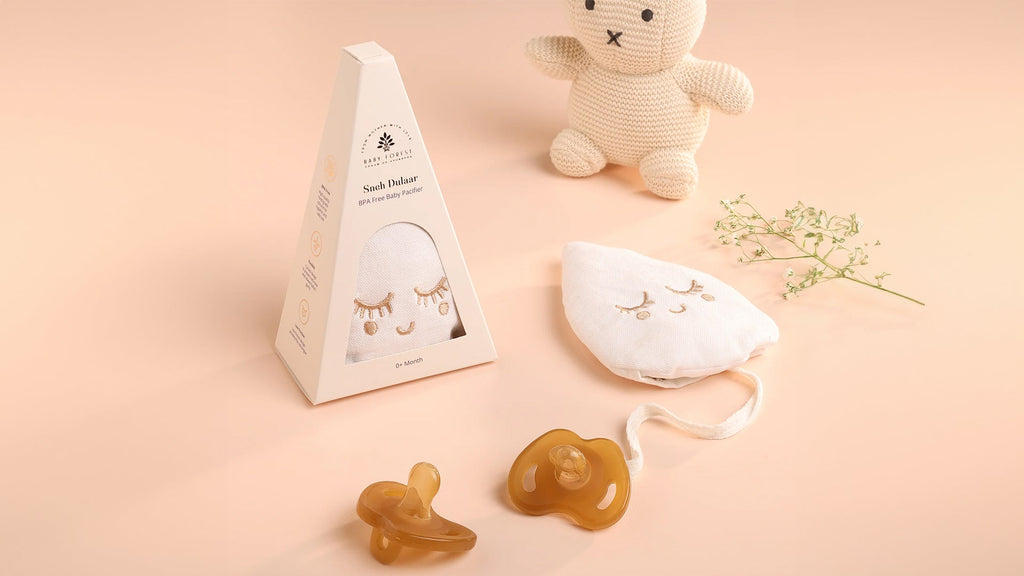
How to Choose the Right Pacifier for Your Baby's Comfort ...
A pacifier for baby can be incredibly helpful for parents, as it can calm a restless baby, encourage sleep, and lower the risk of Sudden Infant Death Syndrome (SIDS). But with so many options in the market, choosing the right pacifier for your baby's comfort and sleep isn't always easy. This blog will guide you through everything you need to know about selecting, using, and maintaining the right pacifier for your baby.
Understanding Baby Pacifiers
Pacifiers are small, nipple-like gadgets made specifically for babies' oral comfort. They come in various shapes and materials, but their primary function is to provide a soothing effect that mimics the comfort babies get from breastfeeding. A good pacifier can significantly calm your baby, helping them feel secure and relaxed, which promotes better sleep.
Selecting the Right Baby Pacifier
When choosing a pacifier, consider these important features:
Material
Look for pacifiers made from food-grade silicone that are durable, soft, and BPA-free to ensure your baby's safety.
Design
A low-friction, flexible design with a skin-like texture can mimic the feel of a mother's breast, making it more likely for your baby to accept the pacifier.
Safety Features
Ensure the pacifier has ventilation holes to prevent saliva buildup and skin irritation around your baby's mouth.
Shape
Orthodontic pacifiers are designed to prevent dental issues later on and support proper oral development. Choosing a pacifier for a baby that combines these elements will contribute to a safer, more comforting experience.
Safety and Hygiene Suggestions
You should always keep your baby's pacifier clean to preventing infections. Wash the baby pacifier with mild, soapy water before its first use and before each subsequent use. It is crucial to examine the pacifier nipple frequently for any indications of wear or harm, and if any defects are found, it should be replaced immediately. Additionally, it is essential to store the pacifier in a dry location, away from direct sunlight and heat sources. Remember, pacifiers should not be sterilized by boiling or subjected to intense heat, as this can degrade the material.
Tips for Introducing a Pacifier
Introducing a pacifier to your baby can be a helpful tool in soothing and comforting them, especially during the early months. However, the timing and method of introduction can play significant roles in how well your baby accepts the pacifier. Here are some tips to help you introduce a pacifier effectively:
Wait Until Breastfeeding is Established
If you are breastfeeding, it's crucial to wait until your baby is proficient at nursing, which typically takes about 3-4 weeks. Introducing a pacifier a little too early can lead to nipple confusion, where the baby might prefer the pacifier over the breast due to the difference in effort needed to extract milk.
Introduce During a Calm Time
You could consider offering the pacifier when your kid is quiet and not too hungry or weary. This can make it easier for your baby to explore the pacifier naturally without associating it with stress or urgent hunger.
Use it to Soothe, Not to Delay Feeding
Use the pacifier to soothe your baby, not as a replacement for feeding. Ensure that your baby is fully fed before offering the pacifier, as this helps prevent misinterpreting their cues for hunger.
Monitor for Any Signs of Discomfort
Monitor and check your baby for any signs of discomfort or rejection. If they consistently refuse the pacifier or seem distressed when using it, take a break and try again another time. Some babies may never take to a pacifier, and that's perfectly okay.
When choosing a pacifier for your baby, it's important to prioritize safety and comfort. By selecting a high-quality, well-designed pacifier and maintaining good hygiene practices, you can provide your baby with a source of comfort that also supports their health and development.
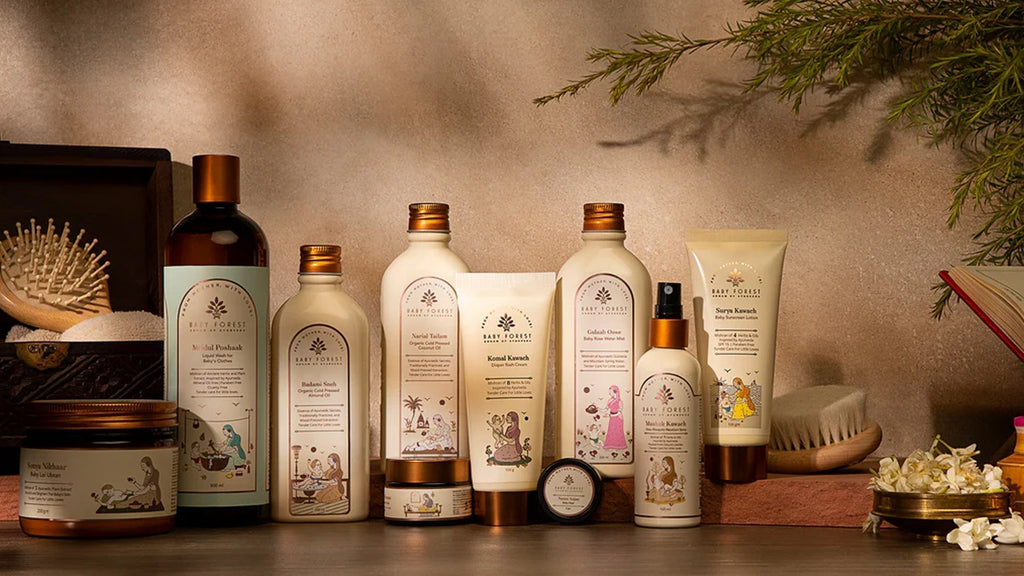
What is the Difference Between Natural Fragrance and Adde...
When it comes to choosing baby products, from lotions and shampoos to baby wipes and creams, parents are faced with a plethora of choices. One aspect that often prompts questions is the difference between natural fragrances and added (or artificial) fragrances in these products. Once you understand these differences, you will be able to make informed decisions for your baby's health and well-being.
What Are Natural Fragrances?
Natural fragrances in products for infants are derived from natural sources, such as plants, flowers, and fruits. These fragrances are obtained through cold pressing, distillation, or extraction. Because they come from natural sources, they often carry the intrinsic benefits of their original plants, such as calming or soothing properties.
Benefits of Natural Fragrances:
-
Gentle on Skin:
For babies with sensitive skin, natural fragrances are less likely to irritate compared to synthetic alternatives. -
Therapeutic Properties:
Some natural fragrances offer therapeutic benefits, like lavender, which is known for its calming effect.
Considerations:
-
Allergies:
Some babies may be allergic to natural ingredients. It's important to monitor for any adverse reactions.
What Are Added (Artificial) Fragrances?
Added or artificial fragrances are chemically created scents designed to mimic natural smells or to create entirely new scents. These fragrances are formulated in labs and can be composed of various chemicals.
Benefits of Added Fragrances:
-
Consistency:
Products with artificial fragrances maintain the same scent over time, providing consistency across batches.
-
Diversity of Scents:
Artificial fragrances can create a wide range of scents that might not be achievable with natural ingredients alone.
Considerations:
-
Skin Sensitivity:
Synthetic fragrances are more likely to irritate sensitive skin, causing reactions such as rashes or redness. -
Health Concerns:
Some studies suggest that certain chemicals in artificial fragrances could have negative health effects over the long term, though more research is needed.
Making the Right Choice for Your Baby
When deciding between baby products with natural or added fragrances, consider the following tips:
-
Know Your Baby's Skin:
If your baby has sensitive skin, opting for fragrance-free or naturally scented products might be the best choice. -
Read Labels Carefully:
Look for products that specify "natural fragrance" or "fragrance-free" if you wish to avoid synthetic scents. -
Patch Test:
Before you use any new product on your baby, do a patch test by applying a small amount on their arm or leg to check for any adverse reactions. -
Consult a Paediatrician:
If in doubt, consulting with your child's paediatrician can provide personalized advice based on your baby's specific health and skin needs.
Whether you choose baby products with natural fragrances, added fragrances, or no fragrances at all depends on your preferences and your baby's skin sensitivity. Being informed and cautious can help ensure that your choices support your baby's health and happiness.
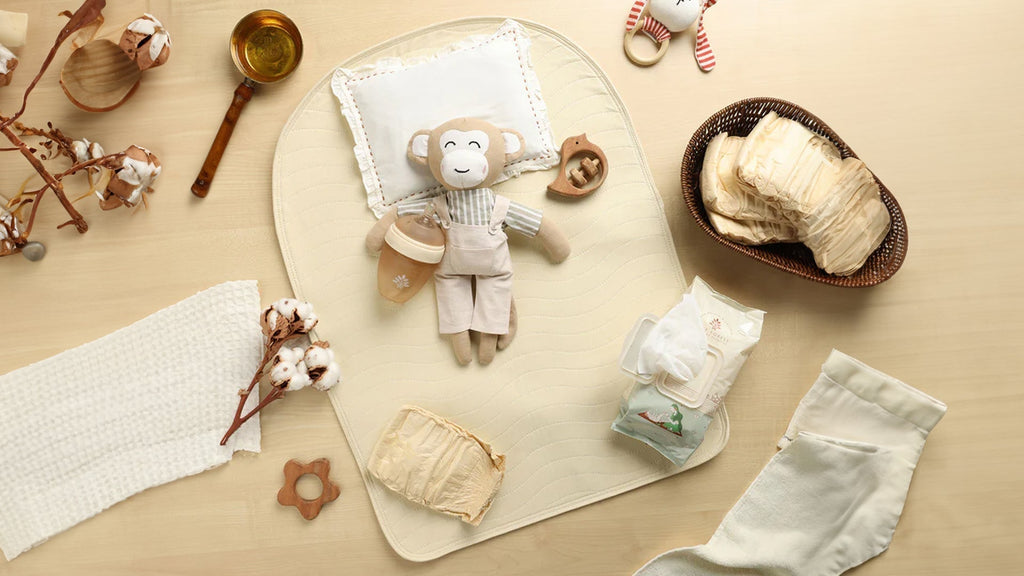
The Benefits of Using Dry Sheets in Diaper Changing and S...
As a parent, your baby's comfort and health are your top priorities. One simple yet effective way to ensure both during diaper changes and sleep time is by incorporating dry sheets into your routine.
What Are Dry Sheets?
Dry sheets, also known as absorbent sheets or waterproof bed protectors, are designed to keep moisture away from your baby's skin and bedding. Made from layers of materials, including absorbent and waterproof fabrics, these sheets are engineered to draw moisture away from the surface, keeping the baby dry and comfortable. Unlike traditional cloth or rubber sheets, modern dry sheets are breathable, soft, and safe for a baby's delicate skin, making them an essential part of baby care routines.
Let's dive into why these little sheets can make a big difference.
-
Keeping Baby Dry and Happy
Dry sheets are designed to provide a waterproof barrier that helps keep moisture away from your baby's skin. During diaper changes, a dry sheet can prevent any accidental leaks from reaching the changing table or any surface you're using. Placing a dry sheet under your little one at night can help manage any leaks, ensuring they stay dry and comfortable. This is crucial because a dry environment is essential for preventing diaper rashes, which are uncomfortable for your baby and stressful to manage.
Related Read - Is Your Baby Suffering From Diaper Rashes? Here Are The Best Ways to Treat Diaper Rashes
-
A Simple Solution for Better Sleep
As we know, babies are sensitive to discomfort, which can interrupt their precious sleep. A wet diaper or any moisture can be particularly disruptive. Using a dry sheet creates an additional layer of protection that helps maintain a dry sleeping environment. This can lead to longer, more peaceful sleep periods for your baby (and, let's face it, for you too!). Better sleep supports their overall development and ensures they're happier during their waking hours. -
Easy Cleanups
Let's talk practicality. Dry sheets are incredibly easy to use and change, making cleanups a breeze. For environmentally conscious parents, there are also reusable options available that can be washed and used again. -
Portable Convenience
Dry sheets are lightweight and portable, making them an essential item in your diaper bag. Whether you're visiting grandparents, enjoying a family outing, or travelling, they ensure that you can provide a clean and dry-changing surface anywhere. This flexibility can make diaper changes on the go less stressful for both you and your baby. -
Protecting Your Gear
Lastly, dry sheets are not just about keeping your baby dry; they also protect your changing tables, cribs, and car seats. Moisture can damage these surfaces over time or require extensive cleaning. Using dry sheets helps preserve the condition and longevity of your baby gear, saving you money and hassle in the long run.
Choosing the Right Dry Sheet
When selecting a dry sheet, consider the following factors to ensure you pick the best one for your baby:
- Material: Search for soft materials that are kind to the skin and devoid of toxic substances.
- Size: Choose a size that fits your baby's crib, cot, or bed snugly, covering the area effectively.
- Absorbency: Opt for sheets with high absorbency to keep moisture away from your baby's skin.
- Ease of Cleaning: Dry sheets that are machine washable and quick to dry will make your life easier.
Tips for Using Dry Sheets Effectively
- Regular Rotation: Have multiple dry sheets on hand to ensure you always have a clean one ready for use.
- Proper Placement: Ensure the dry sheet is laid out flat and securely in place to prevent bunching or shifting.
- Layering: For added protection, consider layering a dry sheet over a regular fitted sheet.
- Monitoring: Regularly check the dry sheet for dampness and change it immediately if it's wet to keep your baby dry and comfortable.
Beyond Dry Sheets: A Holistic Approach to Baby Comfort
While dry sheets are fantastic, they're just one piece of the puzzle. Here are additional tips to ensure your baby's ultimate comfort and well-being:
-
Choose the Right Diapers:
Opt for high-quality, absorbent diapers that fit well. The right diaper can make a significant difference in preventing leaks and discomfort. -
Regular Diaper Changes:
Keep your baby fresh and comfortable by changing diapers regularly, especially before bedtime or after meals. -
Diaper Rash Creams:
Have a good diaper rash cream on hand. Applying a barrier cream can provide an extra layer of protection against moisture.

-
Comfortable Sleep Environment:
Ensure your baby's sleeping area is quiet, dark, and at a comfortable temperature. Establishing a regular bedtime routine can enhance the quality of your sleep. -
Hydration and Diet:
For older babies, adequate hydration and a balanced diet can influence diaper habits, making them more predictable and manageable. -
Parental Self-Care:
Remember, a relaxed and happy parent can better attend to a baby's needs. Taking care of yourself is also taking care of your baby.
Dry sheets are a game-changer for new parents, offering unparalleled convenience, hygiene, and comfort for babies during diaper changes and sleep time. By choosing the right dry sheet and using it effectively, parents can ensure their little ones stay dry, comfortable, and happy. Remember, the journey of parenthood is filled with trials and errors, but with the right tools and a loving heart, every challenge becomes a stepping stone towards a fulfilling experience.
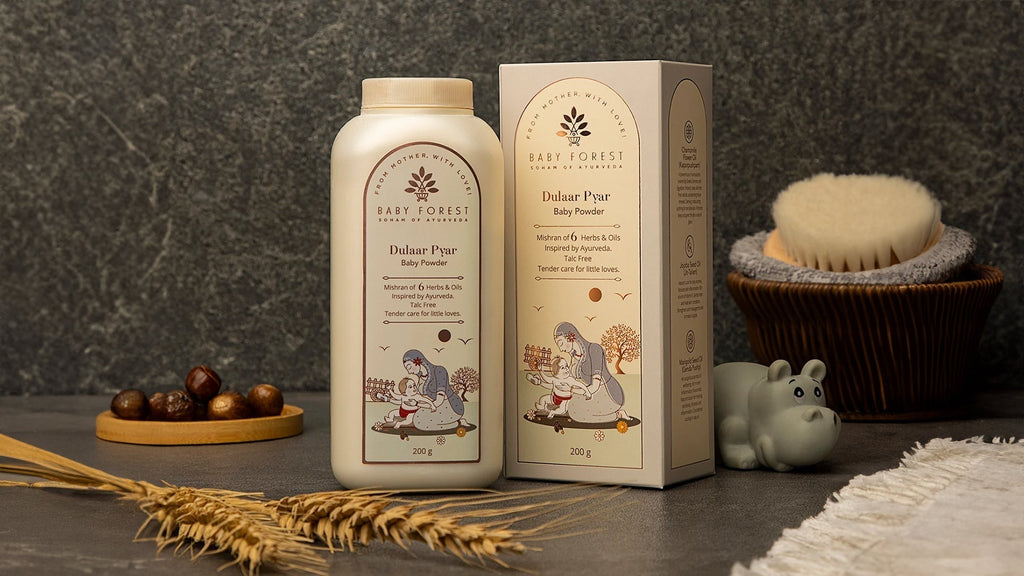
Why Talc-Free Baby Powder is a Must for Summer Heat?
As temperatures soar during the summer months, keeping the little ones comfortable becomes a priority for every parent. An essential item in many households is baby powder, especially to combat the heat and humidity that can cause discomfort and skin rashes in babies. However, the type of baby powder you choose is crucial. In this blog, we'll explore why talc-free baby powder is a safer and healthier choice for your baby during the hot season.
All About Talc and Its Concerns
Traditionally, a lot of baby powders used to have talc in them, which is basically made up of magnesium, silicon, and oxygen. Talc is popular because it's really good at soaking up moisture and reducing friction that causes chaffing , which is why it was often used in baby powders and other beauty products. However, there have been a few concerns about talc's safety over the years. The main issue is its potential contamination with asbestos, a known carcinogen, and the risk of respiratory problems if infants inhale the fine particles.
In light of these concerns, many parents and health experts advocate for the use of talc-free products, particularly for babies who are more vulnerable to the adverse effects of these particles.
What is Talc-free Baby Powders?
Talc-free baby powders are a gentle alternative to traditional baby powders that contain talc, a mineral known for its moisture-absorbing properties. Instead of talc, these powders use natural, plant-based ingredients such as Cornstarch, Chamomile Oil, and Oats Kernel, which are equally effective at keeping moisture at bay without the associated health risks of talc, such as potential contamination with asbestos and respiratory issues from inhalation.
Benefits of Talc-Free Baby Powder
-
Safer Ingredients:
Talc-free baby powders are usually made with cornstarch or other plant-based ingredients like aloe vera. These natural alternatives are gentle on the baby's sensitive skin and are free from asbestos risks. -
Prevents Rash:
During summer, the risk of rashes increases due to the heat and humidity. Talc-free baby powders absorb excess moisture naturally, keeping the baby's skin dry and comfortable, thereby preventing rashes. Additionally you can use Rash Healing cream. -
Avoids Respiratory Risks:
The particles in talc-free powders are generally larger and less likely to be inhaled than those in talc-based powders. This reduces the risk of respiratory problems, which can be serious for children. -
Natural Skin Care:
Many talc-free powders contain additional natural ingredients that benefit the baby's skin. Ingredients like aloe vera and chamomile can help soothe the skin and prevent irritation, making them ideal for use in sensitive diaper areas during the hot months.
Choosing the Right Talc-Free Baby Powder
When selecting a talc-free baby powder, look for products that are:
-
Natural:
Ensures that the product is free from harmful chemicals and genetically modified organisms. -
Artificial Fragrance-Free:
Added fragrances can irritate a baby's delicate skin. Opt for products with no added fragrance to avoid potential allergens. -
Derma Safe:
Choose products that are derma-safe and approved for use on sensitive skin.
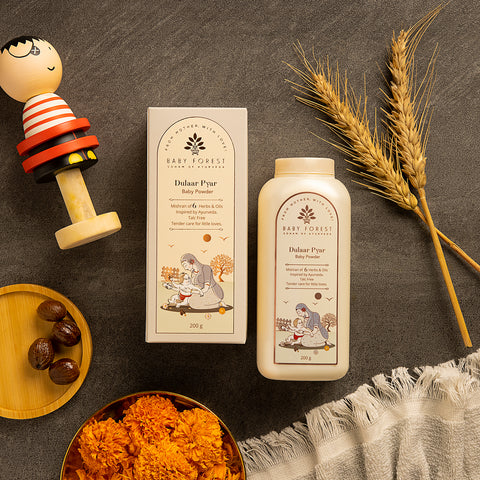
How to Use Talc-Free Baby Powder Safely
To maximize benefits and minimize any risks, even with talc-free powders, it's important to use baby powder correctly:
-
Apply Sparingly:
Use a small amount of powder and keep it away from the baby's face and eyes to avoid inhalation. -
Direct Application:
Apply the powder directly to your hands, away from the baby, and then to the baby's skin. This method helps to control the amount of airborne particles.
Talc-free baby powder is a much safer and healthier option for summer baby care. By incorporating talc-free baby powder into your daily routine, you can ensure that your baby enjoys the summer safely and comfortably. With natural ingredients that are gentle on the skin and effective at moisture absorption, talc-free powders can help keep your baby dry, comfortable, and happy during the hot weather. Always opt for natural, cruelty-free, and derma-safe products to ensure the best care for your little one's delicate skin. Enjoy a worry-free summer with the right products for your baby's needs! Whether at home or on the go, this simple change can make a big difference in your baby's well-being during the warm season.
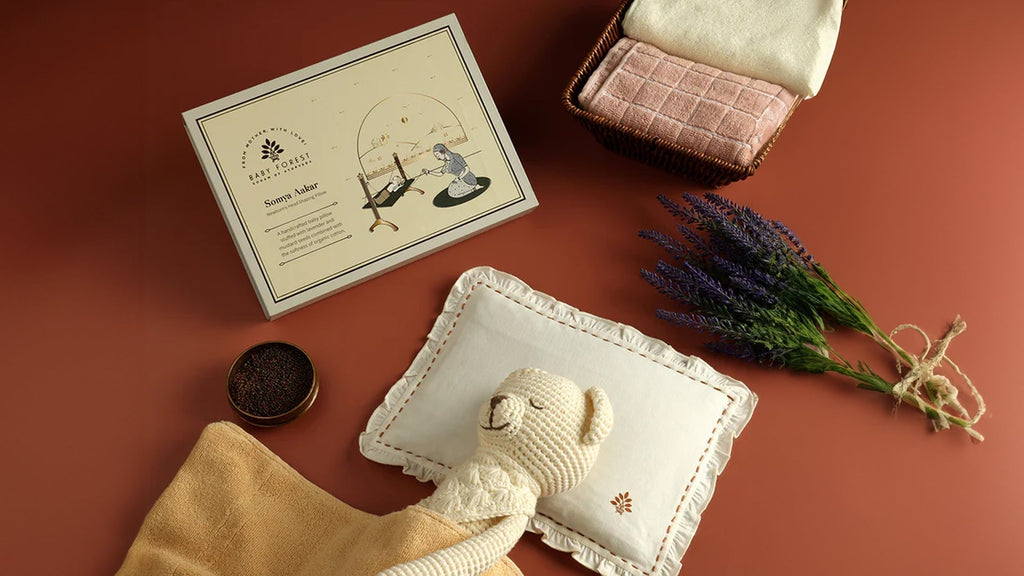
A Comprehensive Guide To Choose The best pillow for your ...
When you welcome a new baby into your home, every little decision can seem overwhelming, especially when it comes to ensuring their comfort and safety. One such decision is choosing the right pillow for your newborn. With a myriad of options available, it's crucial to select a pillow that not only provides the necessary support but also aligns with your baby's health and developmental needs. In this guide, we'll explore why the mustard seed pillow is considered one of the best choices for newborns and also understand its numerous benefits.
Understanding your Newborns' Needs
Before we discuss the specifics of pillows for newborns, let's discuss why newborns need different support than older babies and adults. Newborns have delicate structures, including their neck, spine, and head. They require a pillow that supports natural posture, prevents flat head syndrome, and ensures a safe & comfortable sleep environment. The choice of pillow can significantly impact their well-being and development during these critical early months.
Mustard Seed Pillow for Newborns: An Ancient Solution
The mustard seed pillow is not a new invention but rather a traditional solution that has been used for generations in many cultures around the world. This type of pillow is filled with tiny mustard seeds, which provide a firm yet adjustable surface for your baby's head. The flexibility of the mustard seeds allows the pillow to mould perfectly to the shape of your baby's head, providing support without unnecessary pressure.

Benefits of a Mustard Seed Pillow for Newborn
-
Prevents Flat Head Syndrome
One of the most significant benefits of using a mustard seed pillow is its ability to prevent the development of flat head syndrome. This condition, known as plagiocephaly, develops when a baby's head flattens because of sustained pressure on a specific spot. The malleable nature of the mustard seed pillow helps distribute pressure evenly around the baby's head, reducing the risk of flat spots.
-
Natural and Safe:
Mustard seeds are completely natural and non-toxic, making them a safe filling for newborn pillows. Unlike synthetic materials, mustard seeds do not emit harmful chemicals that could irritate your baby's sensitive skin or respiratory system.
-
Supports Neck and Spine:
One of the standout benefits of the mustard seed pillow is its exceptional ability to support the delicate neck and spine of a newborn. The unique structure of the mustard seeds allows the pillow to conform naturally to the shape of the baby's head, guaranteeing that the neck and spine maintain a neutral alignment. This alignment is crucial for preventing any strain on these developing areas and promotes a healthy posture from an early age. By distributing the baby's head weight evenly, the mustard seed pillow reduces the risk of common issues like flat head syndrome while simultaneously providing the necessary support for the neck and spine
-
Durable and Long-lasting:
Mustard seed pillows are incredibly durable and can last for many years if properly cared for. They do not lose their shape or support over time, unlike foam or feather pillows, which can become lumpy or flat.
Related Read - Mustard Seeds Pillow Benefits: Ideal for Your Newborn's Comfort and Health
How to Find the Ideal Newborn Pillow?
The ideal newborn pillow should be firm enough to support the baby's head yet soft enough to prevent any undue pressure that could lead to flat spots. It should be made of natural, breathable materials to maintain a comfortable temperature and be adjustable to cater to the growing baby's needs. A mustard seed pillow embodies these characteristics perfectly, offering a traditional yet effective solution for newborn sleep comfort.
Care and Maintenance
Caring for a mustard seed pillow is straightforward. Regularly airing the pillow and exposing it to sunlight can help maintain its freshness and prevent moisture buildup. The pillow cover should be washable for easy cleaning. You should keep checking the pillow regularly for any signs of wear and tear to ensure it remains safe and effective for use.
Conclusion
Choosing the best pillow for your newborn is a critical decision that can affect their comfort, safety, and development. The mustard seed pillow, with its natural, adjustable, and supportive properties, stands out as an excellent choice for many parents. By understanding the benefits of a mustard seed pillow and knowing what to look for when choosing one, you can provide your baby with a comfortable, supportive sleeping environment that promotes healthy growth and development. Remember, every baby is unique, so it's essential to consider your child's specific needs when making your selection. Here's to peaceful nights and healthy babies!
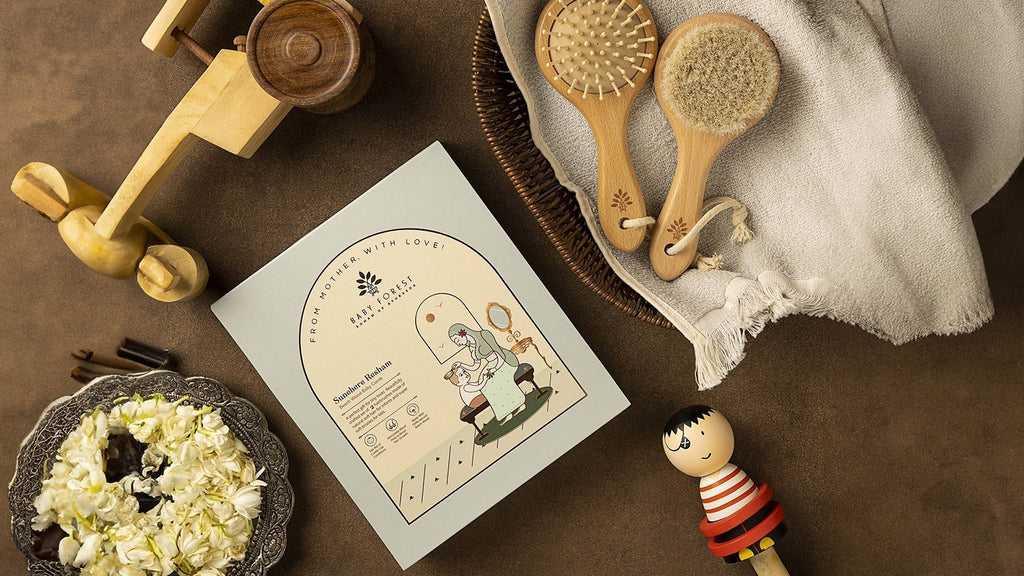
The Importance of Using a Gentle Comb for Your Baby's Hair
Infant hair care is more than a simple grooming routine; it's an essential part of their overall health and well-being. Babies' hair and scalp are very delicate, and they require gentle care to prevent discomfort or harm. This article will explain why using a gentle comb for your baby's hair is crucial, highlight the risks associated with regular combs, and outline the features and benefits of a gentle baby comb.
Understanding Baby's Hair and Scalp
Baby’s scalp is sensitive, and their hair is fine and fragile. Their skin and hair are still developing and can be easily irritated by rough handling or harsh materials. A baby's scalp can also be prone to conditions like cradle cap, which involves patchy, scaly skin. Hence, gentle care is essential to avoid aggravating these conditions or causing discomfort.
The Risks of Using Regular Combs
Regular combs, designed for adults or older children, are often too harsh for a baby's tender scalp. Their hard materials and sharp teeth can scratch or irritate the skin, leading to discomfort or even skin infections. Moreover, these combs can tug at fine baby hair, causing breakage or pain during grooming.
How to Choose the Right Baby Comb
When you look at buying a baby comb, you can consider the following factors:
-
Material:
Look for natural materials like wood and soft goat hair that are safe and gentle for your baby. -
Design:
Choose a comb with rounded teeth and a comfortable handle for easy and safe grooming. -
Size:
A compact size is preferable for the precise combing of fine baby hair and for convenient storage.
Features of Baby Forest’s Gentle Baby Comb
Our gentle baby comb is designed with the baby's delicate scalp and hair in mind.
-
Super Soft Goat Hair:
Ideal for infants and kids, these bristles are gentle enough to massage the scalp without causing irritation. -
100% Natural Beech Wood:
This baby comb is not only eco-friendly but also exceptionally durable and safe for the baby. -
Specially Designed Teeth:
The teeth of the baby comb are rounded and spaced to glide through fine hair without pulling or snagging.
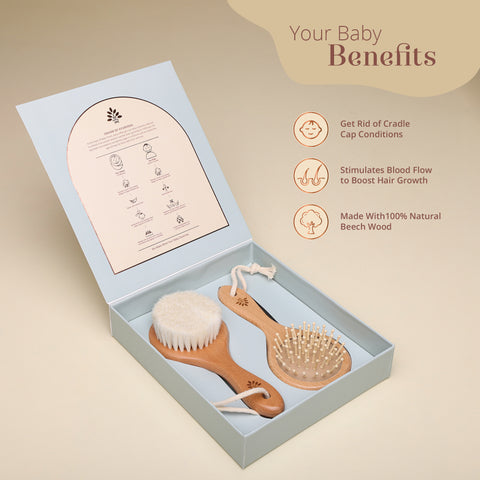
Benefits of Regularly Combing Your Baby's Hair with a Gentle Comb
Regularly combing your baby's hair with a gentle comb is more than just a routine grooming activity; it is an essential practice that offers numerous benefits for both the baby and the parent.
-
Promotes Healthy Hair Growth
Combing regularly with a soft comb aids in stimulating the scalp, which boosts blood flow to the hair roots. This stimulation promotes healthier and stronger hair growth by ensuring that the hair follicles receive ample nutrients and oxygen. Even spreading the scalp's natural oils along the hair shaft nourishes the hair, thus reducing its susceptibility to breaking.
-
Detects and Prevents Scalp Issues Early
Regular combing allows parents to closely inspect their baby's scalp regularly, making it easier to spot any potential issues such as dryness, cradle cap, or unusual spots early on. Early detection means that any conditions can be addressed promptly, preventing discomfort for the baby and potentially avoiding more serious complications.
-
Alleviates Cradle Cap
Cradle caps, characterized by scaly or crusty patches on the scalp, are common in babies. Regularly combing your baby's hair with a gentle comb can help loosen and remove these scales in a gentle manner, especially when combined with appropriate baby oil or shampoo. This keeps the baby's scalp clean and helps alleviate the symptoms of cradle cap.
Related Read - Dealing with Cradle Cap: Causes, Treatment Options, and Proactive Prevention
Combing Techniques and Tips
To make the most of your infant's hair care routine, consider these tips:
-
Gentle Approach:
Always comb gently, starting from the tips and working your way up to the roots to detangle hair without pulling. -
Regular Routine:
Make combing a part of your daily routine to keep your baby's hair neat and to monitor the health of their scalp. -
Cleanliness:
Keep the comb clean to prevent the buildup of oils or cradle cap flakes, ensuring hygiene.
Related Read - An Ideal Hair Care For Babies- What You Must Know?
ConclusionCaring for your baby's hair with a gentle hairbrush is an act of love and attention. It not only ensures their comfort but also promotes healthy hair growth and scalp health. Combing your baby's hair is a loving gesture that keeps them comfortable and supports their hair and scalp health. Choose the right newborn hairbrush and comb their hair gently, making it a soothing and bonding experience. Remember, the key is to be gentle and patient and to use the right tools to care for your baby's delicate hair and scalp.
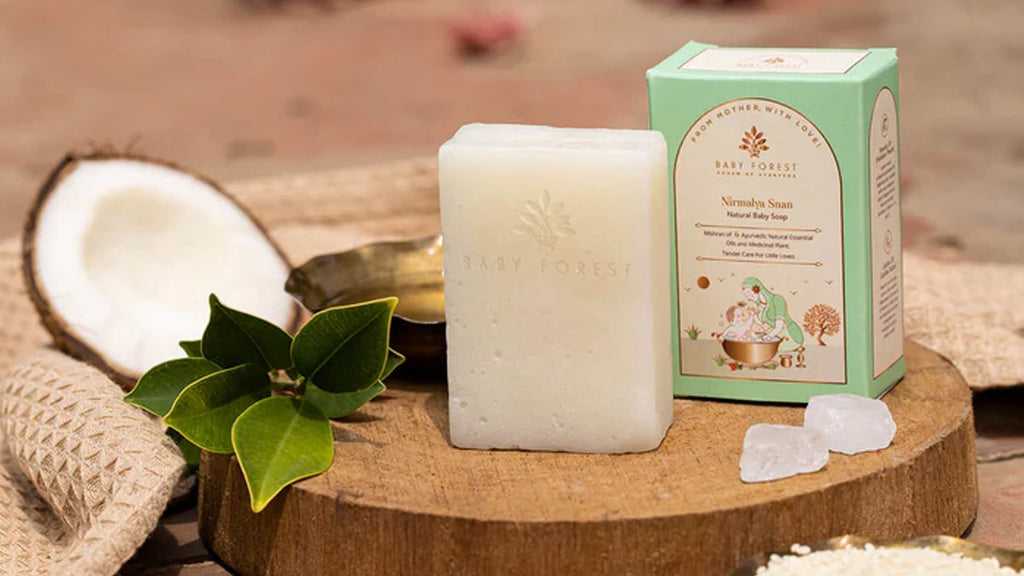
Natural Baby Soaps for Chemical-Free Bath Time
Because so many household goods include chemicals, it is essential that we put our children's health first when it comes to the purity of the products they use. Whether your kid is seven days, seven weeks, or seven months old, one thing remains constant: their sensitive and gentle skin. As a result, many bath and skin care products you use on yourself might cause rashes and irritation. Parents have become increasingly mindful of choosing baby products, which has led to a growing preference for natural baby products.
Bathing your baby is not just a task but a nurturing experience for their well-being. This blog will help you understand the benefits of choosing natural baby soaps and provide guidance on how to select the best soap for infants, guaranteeing a chemical-free bathing experience.
Why Choose Natural Baby Soaps?
Our skin is the biggest part of our body that shields our insides from the outside world. This is especially important for babies because their skin is significantly thinner than that of adults. This makes a baby's skin more delicate and also lets chemicals from normal soap get into the skin more easily. One study found that babies exposed to harsh soaps and shampoos are more likely to get skin problems like eczema and other skin irritations.
This is where natural baby soaps help with their organic ingredients, which makes it safer with no synthetic smells or harsh chemicals in them. These soaps only contain natural ingredients like coconut oil and shea butter. These natural ingredients are gentle and soft on a baby's skin.
How to Choose the Right Natural Baby Soap for Your Baby?
Choosing the right natural baby soap is crucial for your little one's delicate skin. With so many alternatives available, it might be difficult to choose the best one. However, focusing on specific qualities and ingredients can guide you in making a healthier choice for your baby. Here's how to ensure the soap you select is gentle, safe, and beneficial for your baby's bath time.
-
Paraben-Free
Parabens are preservatives used to prolong the shelf life of products, but they can disrupt hormone function, which is especially risky for babies. Opting for paraben-free baby soap ensures that your child is not exposed to these chemicals, making bath time safer.
-
Tear-Free
A tear-free formula is essential for baby soaps to prevent eye irritation during bath time. This means the soap is gentle enough that it won't sting your baby's sensitive eyes, making for a more pleasant bathing experience for both of you.
-
Natural Ingredients
Natural ingredients are the cornerstone of a good baby soap. Look at infant soaps with ingredients such as Jojoba Oil, Castor Oil, Coconut Oil, Sesame Oil, Rosehip Oil, and Aloe Vera. Chemical additives can be harsh on a baby's skin, leading to dryness and irritation. Natural soaps, on the other hand, use ingredients that are gentle and nourishing.
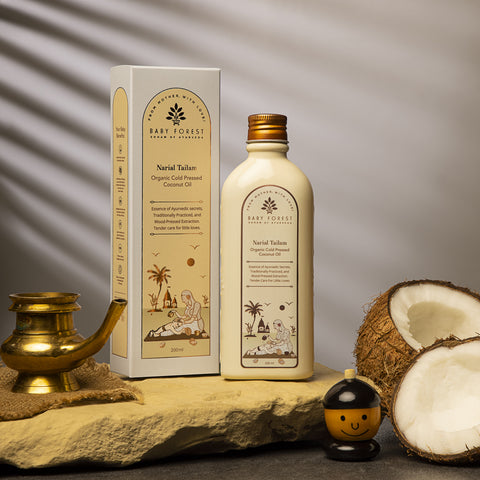
-
Vegan
Vegan baby soaps are made without any animal products or by-products, aligning with eco-friendly and cruelty-free practices. These soaps are also more likely to contain plant-based ingredients that are gentle and beneficial for the skin.
How to Use Baby Forest's Nirmalya Snan Natural Baby Soap?
To use the soap bar, simply wet your baby's skin with warm water, then gently rub the soap bar over their skin to create a soft lather. Massage the lather gently across their body with your hands or a soft washcloth. After ensuring their skin is thoroughly cleansed, rinse off the lather with plenty of water, making sure no soap residue remains.
When choosing baby care products, it's important to consider your child's well-being and the environment. Natural baby soaps are a great option, as they are gentle on your baby's skin and free from harsh chemicals. This helps create a safe and enjoyable bathtime experience for your little one. By choosing natural products, you're also contributing to a more sustainable world, reducing your exposure to harmful chemicals. This is a worthwhile investment in your child's health and the future of our planet.

Benefits of Baby Rose Water for Your Little One
Caring for your baby's skin is as essential as nurturing their health. In a world teeming with baby skin care products, finding the gentlest and most natural option for your little one can be a challenge. Among the myriad choices, baby rose water stands out as a remarkable solution that not only pampers but also benefits your baby's delicate skin.
Crafted from the essence of native rose petals, it brings nature's best to your baby's skincare routine. Here are a few
Benefits of incorporating baby rose water into your daily routine:
-
Soothing Calmness
The core ingredient, Rosa Damascena flower water, is renowned for its calming properties. Native rose petals are carefully selected and distilled to create rose water and it offers a soothing touch to your baby's skin. The natural fragrance of roses is not just a scent but a sensory experience that calms the mind and body. It's like wrapping your baby in a soft, fragrant hug that soothes them into peacefulness. The delicate aroma of roses also ensures your baby enjoys a luxurious, calming bath time, making it a serene ritual.
-
Hydration and Nourishment
Baby rose water is a fantastic hydrator. Due to its vital formulation, enriched with Vitamin E, it aids in preserving the skin's moisture barrier, which helps in avoiding dryness and ensures the skin remains smooth and pliable. This works as a natural moisturizer that absorbs easily without leaving any greasy residue, ensuring your baby's skin remains hydrated and nourished. -
Natural and Safe Ingredients
When choosing rose water for your baby, it's crucial to opt for a product with natural and safe ingredients. A formula comprising Rosa Damascena Flower Water and Vitamin E, without any added chemicals, is ideal. This ensures that the product is gentle on your baby's skin and free from any harmful substances. By selecting a natural, cruelty-free, and derma safe rose water, you provide your baby with the safest and most loving care.
-
Versatility
Its natural soothing properties make it an excellent choice for various situations – from diaper changes to after bath time, ensuring your baby's skin remains clean, calm, and refreshed. On hot and humid days, a quick spritz of rose water can provide an instant refreshment for your baby, helping to cool and soothe their delicate skin. The gentle fragrance of rose water also adds a mild, pleasant scent that can comfort and relax your baby, making it a perfect, all-natural way to enhance their overall well-being and comfort throughout the day.
Pro Tip for Using the Gulaab Oose - Baby Rose Water Mist:
To enhance the nourishment and softness, combine a few drops of the rose water mist with Loi Ubtan Powder and gently massage it into your baby's skin. This blends not only hydrates but also leaves the skin incredibly soft, supple, and with a healthy glow. It's a simple yet effective way to enhance the natural benefits of rose water, providing your baby with the ultimate skincare treatment.
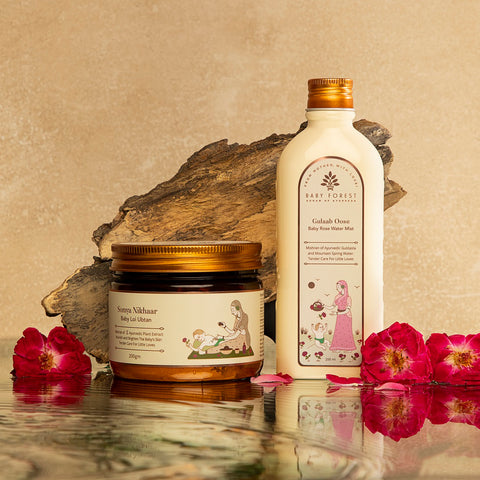
Related Read - Baby Loi Ubtan: Traditional & Modern Care for Stylish Moms
Selecting the appropriate skincare products for your baby is crucial. By choosing a product that is natural, cruelty-free, and free from harsh chemicals, you're guaranteeing that your baby benefits from the finest offerings of nature. Incorporate baby rose water into your baby's skincare routine for a touch of nature's gentleness and purity, embracing its benefits for a happy, healthy baby.
Whether you're a new parent looking for inspiration for the perfect baby shower gift ideas or simply looking for any essential baby care product, like the best baby lotion, our resources are designed to guide you every step of the way.
You can also read more about the traditional and modern significance of using a mustard seed pillow for your little one and explore its various benefits. Or, if you're interested in understanding the richness of Indian ceremonies for your child, our detailed guides on the Annaprashan ceremony and Mundan ceremony will offer insights and practical tips to celebrate these milestones for your little one.
You can read more blogs to ensure that your parenting path is well-informed, joyful, and rich in tradition and care.

The Benefits of Using Water Wipes for Your Baby's Delicat...
In the life of a new parent, every choice made for their little one holds immense significance, especially when it comes to their comfort and health. One such pivotal decision revolves around selecting the right kind of baby wipes for the baby's delicate skin. There are numerous baby products available online, so it becomes crucial to understand why water wipes stand out as the optimal choice for your infant's hygiene and well-being.
Understanding the Delicate Nature of Your Baby's Skin
The skin of a baby is more sensitive when compared to an adult. It is more prone to irritation and allergic reactions when exposed to harsh chemicals commonly found in traditional baby wipes. This is where water wipes come into play. Infused with purified water and natural ingredients like aloe vera extract, these wipes offer a gentle yet effective solution for cleaning your baby without causing any harm.
The Purity of Water Wipes
Water wipes are designed with your baby's health in mind. They are predominantly made of purified water, typically over 99%, ensuring that the wipes are free from harmful chemicals and irritants. The simplicity of water combined with the natural soothing properties of aloe vera makes these wipes ideal for frequent use, reducing the risk of diaper rash and skin irritations.
Ultra-Soft Bamboo Fabric
The choice of material in baby wipes is as crucial as the ingredients. Ultra-soft bamboo fabric is renowned for its natural properties: it's anti-bacterial, hypoallergenic, and, most importantly, incredibly gentle on your baby's skin. Unlike traditional materials, bamboo fabric is more absorbent, ensuring a cleaner wipe with less rubbing, thus preventing redness or inflammation.
No Added Fragrance
Many baby wipes come with added fragrances, which, while pleasant, can lead to skin irritations or allergic reactions. Water wipes, especially those that are unscented, eliminate this risk, making them safe for even the most sensitive skin. By choosing fragrance-free wipes, parents can avoid unnecessary chemicals and ensure a pure and natural cleaning experience for their babies.
Dermatologically Tested
When selecting baby wipes, look for those that are dermatologically tested and approved. This certification attests to their safety, assuring that they are devoid of alcohol, parabens, and other harsh chemicals that may harm your baby's skin. It gives parents peace of mind, knowing that the wet wipes for babies they use have been tested and proven to be gentle and safe for newborns and babies with sensitive skin.
Free from Harmful Chemicals and Alcohol
The absence of harmful chemicals and alcohol in water wipes further underscores their suitability for newborns. Alcohol, commonly found in various cleaning products, can cause drying and irritation to delicate skin. By choosing water wipes, parents can ensure their baby's skin remains hydrated and protected from potential irritants found in conventional wipes.
Environmental Impact and Sustainability
Using bamboo-based water wipes benefits both your baby's skin and the environment. Bamboo is a sustainable and biodegradable material, making these wipes an eco-friendly alternative to traditional options. By opting for water wipes, parents are making a conscious choice to protect their baby's health and contribute positively to the planet's well-being.
How to Use Baby Forest Neer 99.9% Water Baby Wipes
Using Baby Forest Neer 99.9% Water Baby Wipes is a simple and effective way to keep your baby clean and refreshed, whether at home or on the go. Start by opening the lid located at the top of the pack to access the moisture-rich wipes. Gently pull out a single wipe, ensuring that the rest remains covered. Close the lid firmly after each use to retain the wipes' moisture and prevent them from drying out. Use the wipe to gently clean your baby's skin, including the bottom, face, and hands, effectively removing dirt, germs, and impurities. These wipes are designed for delicate skin, making them suitable for frequent use. Dispose of the wipe responsibly after use, and ensure the pack is sealed to maintain the high quality of the remaining wipes.
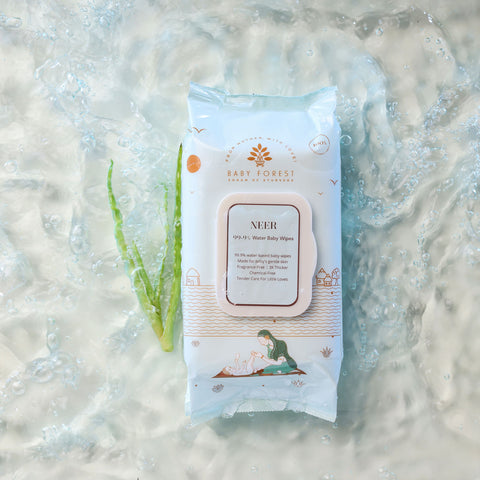
Final Thoughts
The journey of parenthood is full of decisions that shape the health and happiness of your baby. Selecting the right baby wipes is a small yet significant part of this journey. Water wipes, particularly those crafted from ultra-soft bamboo fabric and infused with purified water and aloe vera, offer a safe, gentle, and eco-friendly solution for maintaining your baby's hygiene and comfort.
In embracing water wipes, you are choosing a baby product that aligns with the delicate nature of your baby's skin while supporting sustainable practices. Remember, in the vast sea of choices, the simplest ones are often the best for your baby and the environment.
As you navigate through the early stages of parenthood, let your love and care for your baby guide your decisions. By opting for water wipes, you are ensuring a gentle, pure, and loving touch for your baby's delicate skin, reinforcing your commitment to their health and happiness.

How to Pick Safe Essential Baby Care Products
Navigating the vast world of baby care products can be overwhelming for new parents. You want the best for your little one, ensuring every product, from their lotion to their toys, is safe, gentle, and beneficial for their development. This guide aims to simplify the whole process for you, providing you with the knowledge to choose the best baby products, focusing on safety, natural ingredients, and the well-being of your newborn.
Understanding Baby Care Product Safety
The safety of baby care products lies in their ingredients and materials. Go for products that are free from harmful chemicals and dyes, which can irritate delicate skin or cause allergic reactions. Look for certifications and labels that guarantee products are tested and safe for babies. Reading reviews and researching baby products online can also offer insights into their safety and efficacy.
Essentials for a Safe Nursery
Creating a safe nursery goes beyond aesthetics. It includes choosing organic bedding, hypoallergenic mattresses, and non-toxic paints. Ensure that all furniture is sturdy and meets safety standards. Air purifiers can also contribute to creating a clean, safe environment by reducing potential airborne irritants.
Safe Skincare and Bathing Practices
Babies' skin is incredibly sensitive, requiring products that moisturize and protect without causing harm. Natural and ayurvedic baby skincare products, such as baby face cream and baby lotion made with ingredients such as chamomile, aloe vera, and coconut oil, offer gentle hydration. For bathing, opt for mild, tear-free baby shampoo and baby body wash that cleans without stripping natural oils. Always test products on a small skin area first to check for any reactions.

Choosing Safe Clothing and Diapers
Selecting clothing and diapers for your baby involves more than just comfort and design. Choose organic cotton or bamboo fabrics that are soft, breathable, and free from harmful chemicals. When it comes to diapers, consider cloth options or chemical-free disposables that offer high absorbency without risking diaper rash or exposure to irritants.

Safe Feeding Practices
Feeding your baby safely is paramount. Glass feeding bottles offer a reliable alternative to plastic, mitigating the risk of BPA exposure. When your baby progresses to solids, bamboo baby feeding bowls provide durable and non-toxic choices. Bamboo bowls are especially favoured for their eco-friendly and biodegradable qualities, making them a safe choice for your baby and the environment. Remember to sterilize feeding items thoroughly to ensure they remain hygienic for your baby's use.

Safe Playtime Essentials
Toys play a significant role in your baby's development, but choosing safe playtime essentials is key. Look for toys made from natural materials like organic cotton crochet toys or food-grade silicone. These materials are not only safer but are also environment friendly. Stacking toys, soft books, and sensory balls are excellent for stimulating your baby's senses without the worry of harmful substances.
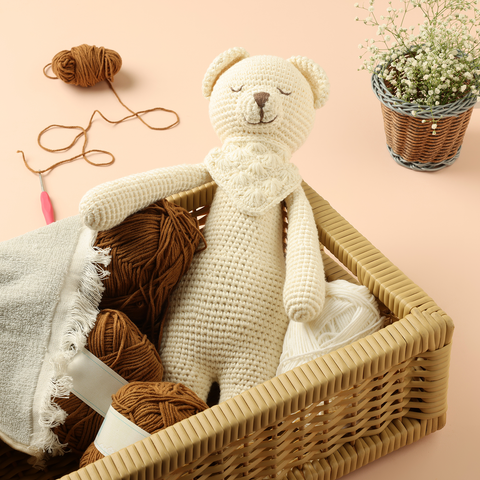
Choosing safe, essential baby care products is a journey filled with love and care. By prioritizing products that are natural, free from harmful chemicals, and designed with your baby's health in mind, you can create a nurturing environment for your little one to grow and thrive. Whether you're purchasing baby skin care products, setting up the nursery, or selecting toys, remember that simplicity and safety go hand in hand. With the correct information and a conscious attitude, you can confidently explore the vast choices of newborn baby products, assuring that you only choose the best for your precious bundle of joy.
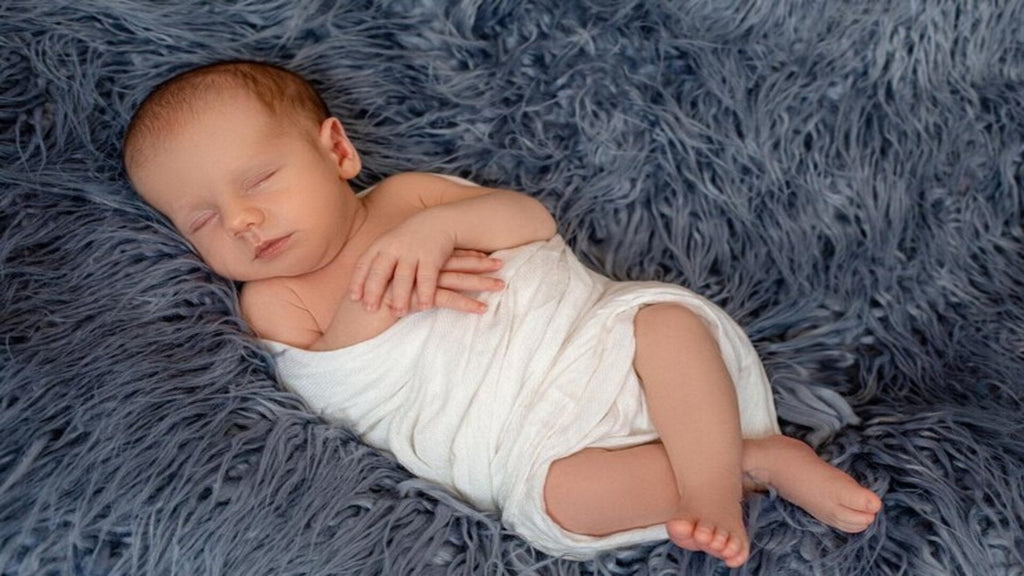
The Essential Guide to Perfect Swaddling: Techniques and ...
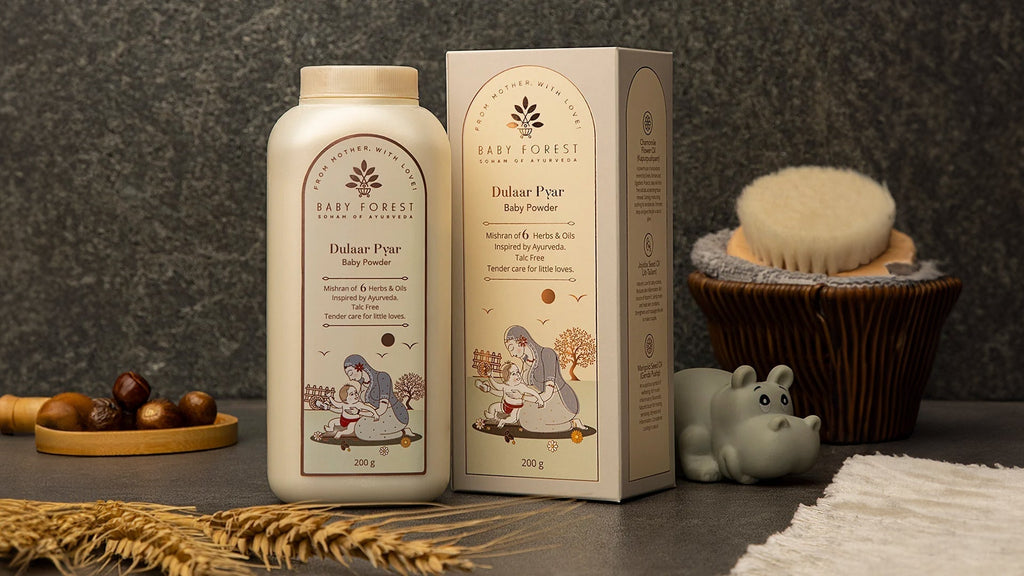
Why Talc-Free Baby Powder Is the Ideal Choice for Infants
When it comes to selecting baby products, parents invariably seek the finest, safest options for their cherished little ones. A significant amount of time is dedicated to meticulously researching and choosing products that promise to be gentle and nurturing for their baby's sensitive skin. Among these products, baby powder has stood as a household staple for generations. Yet, it's crucial for parents to exercise caution, particularly with powders containing talc, as not all baby powders are created equal in terms of safety.
Baby powder, a staple in many households, has come under scrutiny, leading to a shift towards talc-free baby powder. This article delves into why talc-free baby powder is the best choice for your infant, incorporating natural, safe, and gentle ingredients for your peace of mind.
The Shift to Talc-Free
In recent years, the safety of talc-based products has been questioned, prompting parents and manufacturers alike to seek safer alternatives. Talc-free baby powder has emerged as an ideal choice, offering the same benefits without the potential risks associated with talc. But what makes talc-free powder the superior option for infants?
Understanding Talc-Free Baby Powder
Talc-free baby powder is made without talc, a mineral comprised of magnesium, silicon, and oxygen. Instead, it relies on natural and safe alternatives like corn starch, which provides the absorbency and smoothness for which baby powder is known without the associated health concerns.
The Benefits of Going Talc-Free
-
Health and Safety
Talc-free baby powder is gentler on your baby's delicate skin. With no talc as an ingredient, it eliminates the risk of respiratory issues or adverse skin reactions, making it a safer choice for daily use. -
Natural Ingredients
Talc-free baby powders often contain natural ingredients such as chamomile oil, jojoba oil, aloe vera, marigold seed oil, oats kernel, and corn starch. These ingredients not only help in keeping the baby's skin dry but also soothe and nourish it, enhancing the skin's natural barrier. -
Cruelty-Free and Eco-Friendly
Many talc-free baby powders are also cruelty-free, not tested on animals, and are environmentally friendly. This commitment to ethical practices adds an additional layer of appeal for conscientious parents.
Choosing the Best Powder for Your Baby
When selecting a baby powder, looking for talc-free options is just the beginning. The best baby powder for your infant is one that is not only safe but also nourishing for their skin.
-
Chamomile Oil:
It has soothing effects and can help soothe sensitive skin, making it an ideal element in baby powder. -
Corn Starch:
A natural absorbent, corn starch effectively absorbs moisture, keeping your baby's skin dry and comfortable. -
Jojoba Oil:
This oil closely mimics the skin's natural oils, providing moisturization without clogging pores or causing irritation. -
Aloe Vera:
Aloe vera's healing and soothing characteristics make it ideal for treating diaper rash and other skin irritations. -
Marigold Seed Oil:
Known for its anti-inflammatory properties, marigold seed oil can help reduce redness and promote skin healing. -
Oats Kernel:
Oatmeal not only offers comfort but also contains components that can shield the skin and avert irritation.
Tips for Using Talc-Free Baby Powder
-
Apply with Care
To avoid inhalation, sprinkle the powder on your hands away from your baby before applying it to their skin. -
Focus on Moisture-Prone Areas
Apply baby powder to areas that tend to retain moisture, such as the diaper region, underarms, and skin folds. -
Choose Containers Wisely
Opt for powders in shaker bottles or containers that allow for controlled dispensing to minimize airborne particles.
Addressing Common Concerns
With the transition to talc-free baby powders, some parents may wonder about the effectiveness of these natural alternatives. Rest assured, talc-free powders are equally effective in absorbing moisture and preventing diaper rash. The key is in the quality of the formulation and the blend of natural ingredients used.
Choosing talc-free baby powder helps to ensure your infant's safety and comfort. With natural ingredients that soothe, protect, and care for delicate skin, talc-free powders offer parents a worry-free option for keeping their babies dry and comfortable. As you begin on the road of motherhood, choosing products that meet the highest safety and care requirements demonstrates your love for and devotion to your child's well-being. Remember, the best baby powder is one that keeps your baby happy, healthy, and smiling naturally.

A Guide to Creating the Perfect Sleep Space for Your Baby
As new parents, one of the greatest gifts you can give your baby—and yourselves—is the gift of good sleep. Creating the perfect sleep space for your baby is about more than just aesthetics; it's about fostering a safe, comfortable, and soothing environment that promotes sleep. From choosing the right sleeping gear to establishing a cosy bedtime routine, this guide will help you understand the essentials of setting up a nurturing sleep space for your little one. Incorporating key elements such as how to make baby sleep, ensuring the baby's sleeping position is safe, sleep training baby techniques, and the art of swaddling baby for sleep, we aim to provide you with the knowledge to enhance your baby's sleep quality.
Choosing the Right Sleeping Gear
-
Selecting a Cozy Crib or Bassinet
The crib or bassinet is the centrepiece of your baby's sleep space. Look for a sturdy, well-constructed model that meets safety standards. Ensure it has a firm mattress and fits snugly within the crib or bassinet to prevent any gaps. -
Optimal Bedding Choices
Choose soft, breathable materials for the bedding to ensure your baby remains comfortable throughout the night. Avoid overly plush fabrics that can overheat or pose a suffocation risk. -
Wool Blankets
Wool blankets can keep you warm in winter but trap too much heat in summer. They are great at controlling temperature. Ensure the baby blanket is lightweight and breathable. -
Mustard Pillow
Head shaping mustard pillow can be a great addition since it helps with flat-head syndrome prevention by providing gentle support to distribute the baby's head pressure evenly.
Setting Up a Comfortable Sleep Zone
-
Arranging the Crib or Bassinet
Place the crib or bassinet in a quiet corner of the room, away from windows, heaters, and any cords. This positioning helps in creating a calm, undisturbed sleep area. -
Ensuring Proper Ventilation
Good air circulation is crucial for a comfortable sleep environment. Ensure the room is well-ventilated, maintaining a room temperature that is neither too hot nor too cold.
Creating a Relaxing Sleep Atmosphere
-
Soft Lighting
Use soft, dimmable lighting in the sleep space to help soothe your baby to sleep. Harsh lighting can be stimulating and disrupt the sleep process. -
White Noise or Gentle Sounds
White noise for newborns or other soft, relaxing sounds can be used to block out distracting stimuli and provide a peaceful sleeping environment. Devices designed for baby sleep are widely available and can be very effective.
Dressing Your Baby for Sleep
-
Choosing Appropriate Sleepwear
Select sleepwear that's appropriate for the room's temperature, opting for lightweight, breathable fabrics that won't overheat your baby. -
Swaddling Techniques
Swaddling can provide comfort and security, helping babies to sleep more soundly. Learn safe swaddling techniques to ensure your baby's hips and legs can move freely and avoid overheating. Use a super soft bamboo muslin fabric for your baby’s swaddle because it is lightweight and breathable bamboo muslin fabric lets your baby regulate their body temperature, promoting a comfortable and restful sleep.
Nighttime Routines for a Cozy Sleep Space
-
Establishing Consistent Bedtime Rituals
A consistent bedtime routine can significantly aid in baby sleep training efforts. Bathing, reading, or gentle massages can signal to your baby that it's time to wind down. -
Creating a Sense of Familiarity
Consistency and familiarity help babies feel secure. A predictable sleep environment and routine can make bedtime a much smoother process.
Transitioning to a Crib
As your baby grows, transitioning from a bassinet to a crib is a natural step. Make this transition gradually, starting with naps in the crib to familiarize your baby with the new sleep environment.
Keep in mind every baby is different, so what helps one baby sleep might not help another the same way. Be patient, and don't hesitate to adjust your approach as you learn what makes your baby sleep most peacefully. With love, care, and attention to detail, you can create a haven that supports your baby's sleep needs, laying the foundation for healthy sleep habits that can last a lifetime.
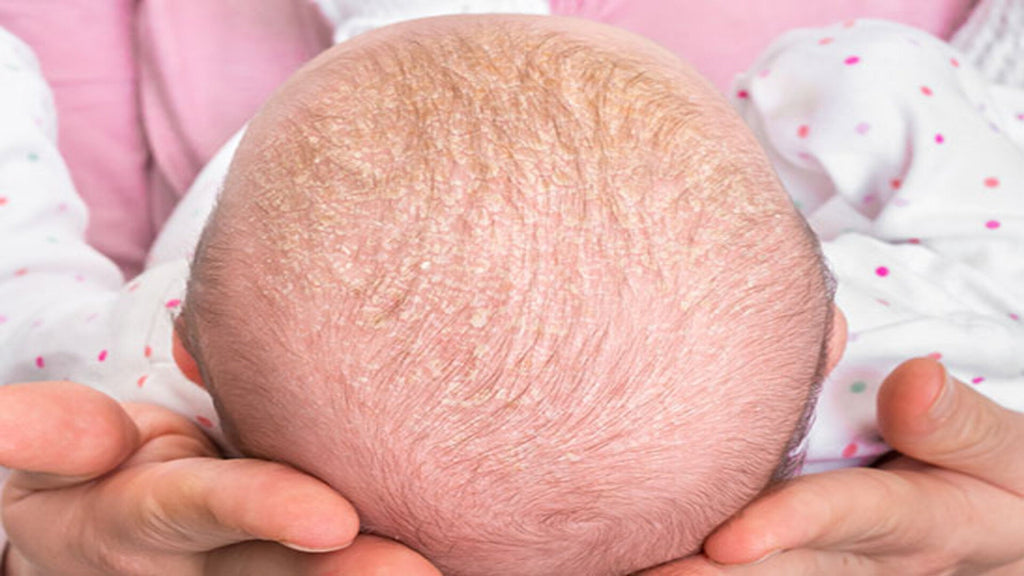
Dealing with Cradle Cap: Causes, Treatment Options, and P...
One common puzzle that many new parents encounter is the cradle cap. This harmless but often perplexing condition can leave tiny scalps looking a bit flaky. In this article, we'll understand cradle cap, its causes, treatment options, and proactive measures parents can take to keep their little one's scalp healthy and happy.
What is a Cradle Cap?
Cradle cap, scientifically termed seborrheic dermatitis, is a prevalent skin condition that commonly manifests in infants within the initial months of their lives. This condition is typically identified by the presence of yellowish, greasy scales on a baby's scalp, making it look like a mild case of dandruff. Though a cradle cap isn't itchy or painful for your baby, it can understandably cause concern for parents.
A cradle cap tends to make its debut in the first few weeks of a baby's life and can persist for a few months. While it might be a bit unsightly, the good news is that the cradle cap in infants is temporary and usually resolves on its own without causing any long-term issues for your little one.
Cradle cap tends to impact approximately 10 per cent of newborns within their first month, with the prevalence soaring to 70 per cent by the time they reach three months old. Surprisingly, the occurrence diminishes significantly to only 7 per cent in infants aged 1 to 2 years.
Causes of Cradle Cap
-
Sebum Overproduction
One of the primary causes of cradle caps is the excess production of sebum, a natural oil that the skin produces. In newborns, the sebaceous glands can go into overdrive, resulting in an excess of this oily substance. When dead skin cells mix with sebum, it results in the characteristic yellowish crust seen in the cradle cap. -
Fungal Involvement
The presence of a fungus known as Malassezia, which resembles yeast, is considered to be another factor that contributes to the problem. While harmless, this fungus can exacerbate the production of sebum and contribute to the development of cradle caps.
-
Environmental Factors
Environmental elements, such as alterations in weather conditions or exposure to abrasive shampoos, can contribute to the onset or exacerbation of cradle cap. Parents can take proactive measures to handle the condition by comprehending and addressing these factors effectively.
Treatment Options for Cradle Cap
Gentle Shampooing
A simple yet effective way to manage cradle caps is through gentle shampooing. Opt for a mild, organic baby shampoo, using warm water to soften the scales before gently massaging and rinsing the scalp.

Scalp Massage
Gently massaging your baby's scalp with your fingers using a natural hair massage oil can help loosen and lift the scales. Massage with a natural and baby friendly hair oil not only aids in the removal of cradle caps but also provides a comforting and bonding experience for both parent and baby.
Brushing or Combing
Using a soft baby brush or comb, carefully brush through the baby's hair to remove loose scales. Be gentle to avoid irritating the scalp, and always ensure the tools are clean and safe for your little one. The Sunehere Resham baby comb is a wooden hairbrush made of natural elements with super soft bristles for infants and kids. It gets rid of the cradle cap and releases natural oils in the baby’s hair and skin without damaging or scratching.

Natural Remedies
For parents who prefer natural remedies, applying a small amount of coconut oil or almond oil to the affected areas before washing can help soften and loosen the scales. Always test a small patch to ensure your baby doesn't have any adverse reactions.

Choosing Organic Baby-Friendly Products
Opting for organic baby products can make a significant difference in preventing and managing cradle caps. Look for shampoos and skincare items with natural ingredients, free from harsh chemicals that could potentially worsen the condition.
When to Consult a pediatrician
While cradle caps are generally harmless, consult your pediatrician if you notice persistent redness or inflammation or if the condition spreads beyond the scalp. In rare cases, a prescription medication may be recommended.
A cradle cap may be a temporary visitor on your baby's scalp, but understanding its causes and treatment options can empower you as a parent. Embrace a gentle and organic approach to your baby's skincare routine, promoting a healthy scalp from the start. By incorporating these proactive measures, you can ensure that the cradle cap becomes just a fleeting moment in your parenting journey, leaving you with a happy and content baby.

Baby Loi Ubtan: Traditional & Modern Care for Stylish Moms
We all have at least one dainty memory of our Dadi maa or Nani maa rubbing the back of an infant with wheat atta loi, especially on a baby's forehead. Since babies are as delicate as rose petals, removing the excess baby hair by loi is pain-free. For these fragile and initial days, using wheat atta lLoi for babies is a perfect Indian tradition with an optimum amount of tenderness! Not as typical as it sounds, a loi is just a tiny amount of wheat dough rolled into a ball and dipped into oil of preference for giving a loi massage to your little one.
The Tradition of Loi in India
The tradition of rubbing a loi has its roots in the ancient heritage of baby care. You must have heard those tales about strong babies with strong muscles during childhood. Well, the seeds of that strength are sowed right in the newborn's first month. The soft massage allows them to handle the force provided by human hands in the next few months. The primary function of this practice is the removal of excess baby hair. But it has several other benefits. The soft atta lLoi takes care of the blood circulation in the most delicate way possible, reducing body hair growth. Along with it, it protects the baby from various toxins as well.
Types of Loi
Just like how every grandma and maa has her own best ways for their babies, the custom of lLoi is also different in every household. Some mothers use oils like sesame, mustard, and coconut oil to dip the dough. In contrast, others believe in adding a pinch of turmeric for protection. The goodness of these ingredients and natural plant extracts is what curates Baby Forest's Baby Loi Ubtan. We bring the concept of Loi and the nourishment of ubtan together in this magical box. Our ayurvedic composition of five ayurvedic plant extracts like wheat, turmeric, besan, licorice powder, and vetiver provides babies with tender care and saves their mothers some time.

Why should you choose Baby Forest's Loi Ubtan?
This Loi Uubtan is unique in its ingredients, texture, and fragrance. Starting with wheat flour, it helps to remove extra hair and acts as an antioxidant and cleanser. Turmeric does its wonder by improving the skin texture of the baby. From the forest of flour, gram flour enhances the skin's softness. At the same time, licorice and vetiver help as a natural coolant and prevent inflammation with their neutral oils. The powdered texture makes it handy and easier to use. You don't have to miss your baby's massage while traveling. The most distinctive advantage of the product is that you can pair it with our Gulaab Oose. The richness of traditional paatalam pushpah cohered with the mishran of vetiver creates a mystical fragrance that is both safe and soothing for the baby and the mother.

Step-By-Step Guide for The Proper Use of Baby Loi Ubtan

Step 1- Take two big spoons of Somya Nikhaar Baby Loi ubtan.

Step 2- Mix the ubtan with the desired quantity of Baby Forest rosewater and purified water.
![]()
Step 3- Create a thick paste and knead soft dough for the baby.

Step 4- Rub that loi in a circular motion on the baby's back, forehead, legs, and arms.
Note: Rub a Loi after giving an oil massage to your baby.
Modern moms need a vogue product for their young ones while keeping the traditional treasure intact. Baby Loi ubtan is a balanced bridge between tradition and urban parenthood.
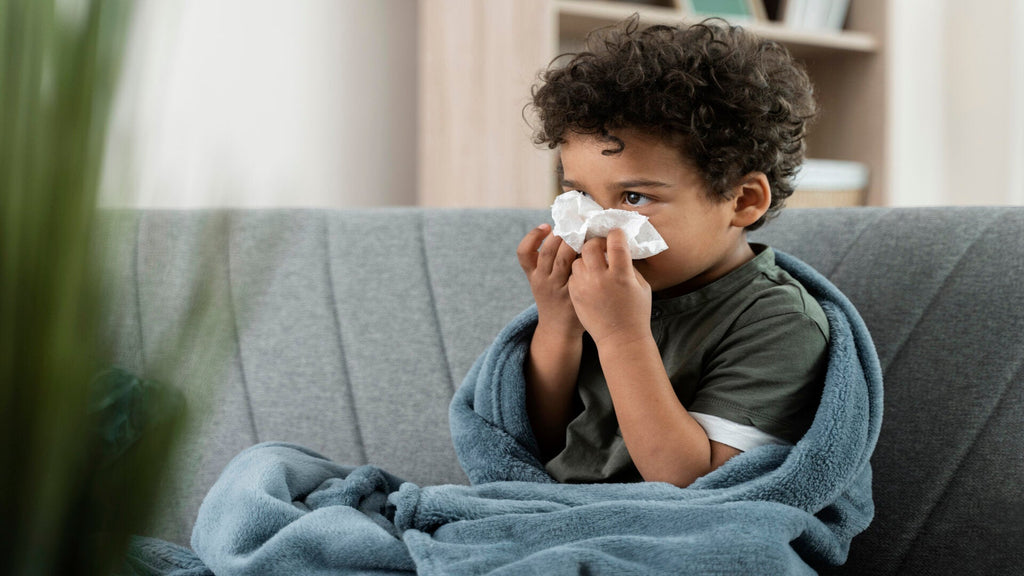
5 Ways for Managing and Soothing Your Baby's Runny Nose
Believe it or not, a runny nose can be a good thing. It's the body's natural mechanism for getting rid of germs. However, when your precious little one is grappling with too much mucus, it can lead to a stuffy head, making it challenging for them to eat, sleep, and breathe comfortably. Dealing with an infant's stuffy nose can be a concern for parents. Fortunately, a few home treatments can bring relief and make your baby comfortable again. In this article, we'll explore five effective ways to manage and soothe your baby's runny nose.
Understanding Baby Nasal Congestion
Causes of Nasal Congestion in Babies
Before diving into remedies, it's crucial to understand the root causes of nasal congestion in infants. Common culprits include viral infections, such as the common cold, allergies, and exposure to irritants like dust or smoke. The nasal passages of babies are narrow, making them more susceptible to blockages. Identifying the cause can help tailor the treatment for optimal results.
Premature babies, with their weaker immune systems, may face additional challenges in warding off infections that can contribute to nasal congestion. Furthermore, infants who have never been breastfed may be more prone to cough and congestion, as breast milk provides essential antibodies and nutrients that support a baby's immune system and respiratory health.
Recognizing Signs of Nasal Congestion
Recognizing the signs of nasal congestion is the first step in addressing the issue. Watch for symptoms like excessive sneezing, difficulty breathing, and a persistent runny nose. Babies may also become fussy, have trouble sleeping, or struggle with feeding due to nasal congestion. Additionally, keep an eye out for the emergence of fever and snoring, which can be indicative of more severe congestion and may require prompt attention. Being attentive to these signs allows for timely intervention.
Safe Methods for Clearing a Baby's Stuffy Nose
-
Nasal Saline Drops
Nasal saline drops are a gentle and effective way to alleviate nasal congestion in babies. These drops help to loosen mucus, making it easier for your little one to breathe. It's easy to administer saline drops to your baby: just tilt their head back a little, inject a few drops into each nostril, and then use a bulb syringe to suction away the mucus that has been released. -
Baby Vapor Rub
Baby vapour rubs are formulated with mild ingredients suitable for infants. Applying a small amount to your baby's chest or back, especially during sleep time, can provide relief by releasing soothing vapours. Komal Shwaas Baby Vapour Rub is a 100% natural baby vapour rub made with the healing powers of plant based Ayurvedic ingredients such as Aloe Vera Oil, Rosemary Oil, Eucalyptus Oil, Lavender Oil, Vitamin E and more. These ingredients not only effectively treat sore throats and promotes better sleep among babies but also offer additional benefits. Aloe Vera Oil soothes and moisturizes the skin, while Rosemary Oil and Eucalyptus Oil help clear breathing pathways and Lavender Oil promotes relaxation. Be sure to select baby care products that are made especially for babies, as adult formulas may contain substances that are too harsh for a baby's sensitive skin. The age group for using Baby Forest’s ayurvedic baby vapour rub is 3 months and older.

-
Steam Therapy
Steam therapy is a natural remedy that helps relieve nasal congestion by loosening mucus and making it easier for your baby to breathe. Run a hot shower and spend some time in the bathroom with your infant to create a steamy atmosphere. Ensure the water temperature is comfortable, and never leave your baby unattended near hot water. -
Elevating the Head
Elevating your baby's head while sleeping can prevent mucus from pooling in the nasal passages, reducing congestion. To create a slight inclination, place a small pillow or rolled-up blanket underneath the crib mattress. This simple adjustment promotes better airflow and aids in the natural drainage of nasal secretions.
Home Remedies and Precautions
-
Hydration
Ensuring your baby stays well-hydrated is essential in managing nasal congestion. Offer frequent feeds, whether through breastfeeding or formula, as the extra fluids can help thin mucus. If your baby has started solids, consider incorporating hydrating foods like soups and purees into their diet. -
Warm Compress
A warm compress can provide relief by soothing the irritated skin around your baby's nose. For a few minutes, gently apply a soft cloth dipped in warm water on your baby's face after wringing off any extra water. This can help alleviate discomfort and make breathing more comfortable. -
Avoiding Irritants
Identifying and minimizing exposure to irritants is crucial for preventing and managing nasal congestion. Keep your baby's environment smoke-free, limit exposure to strong odours or perfumes, and ensure the living space is free from dust and allergens.
When to Seek Professional Help
While most cases of infant nasal congestion can be managed at home, there are instances where professional intervention is necessary. If your baby's symptoms persist or worsen, or if you notice signs of respiratory distress, it's essential to consult with a pediatrician promptly. Timely medical attention can prevent complications and provide peace of mind for concerned parents.
Remember to maintain a hygienic and irritant-free environment, and always consult with a healthcare professional if you have concerns about your baby's nasal congestion. These simple strategies will help your baby breathe easily and enjoy a healthy start to life.



